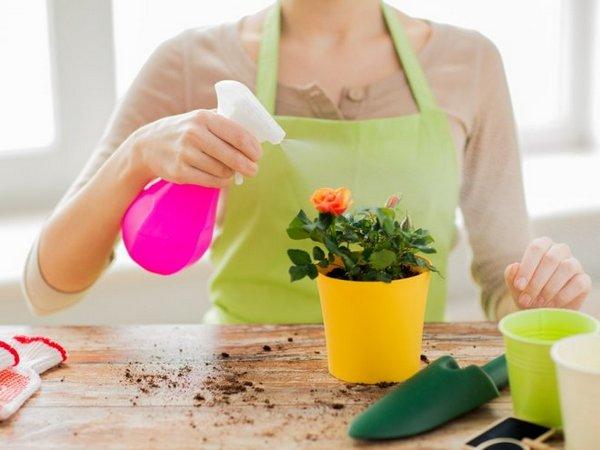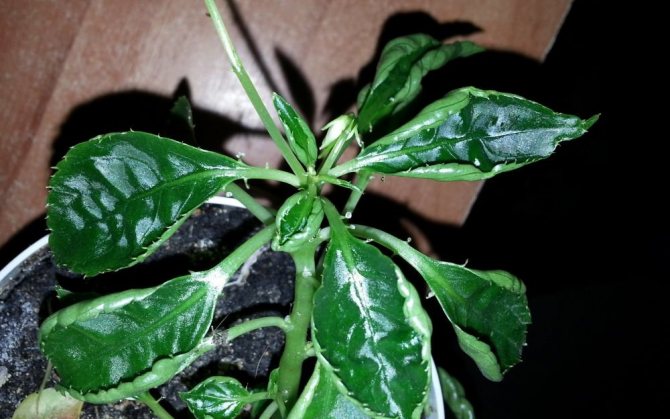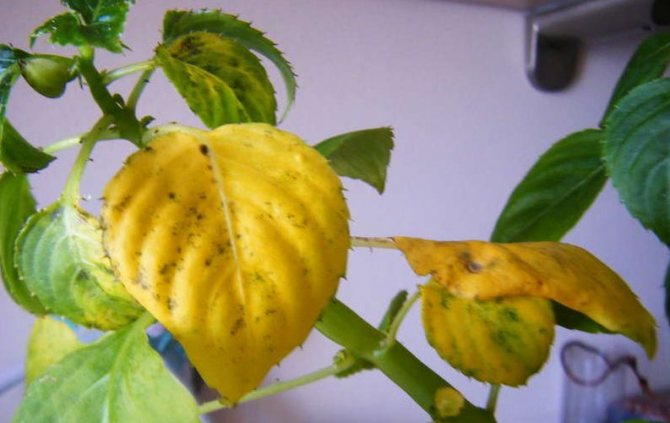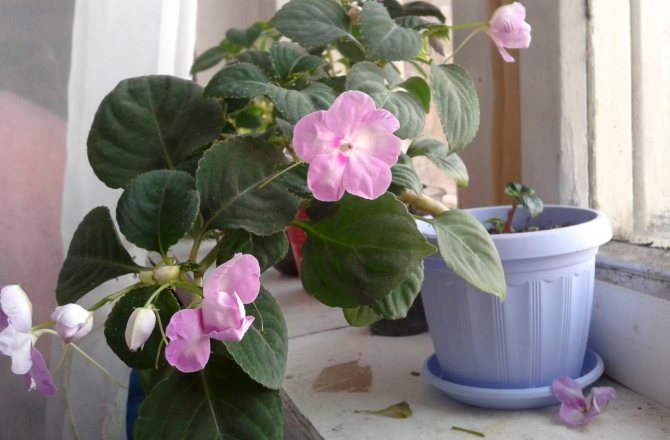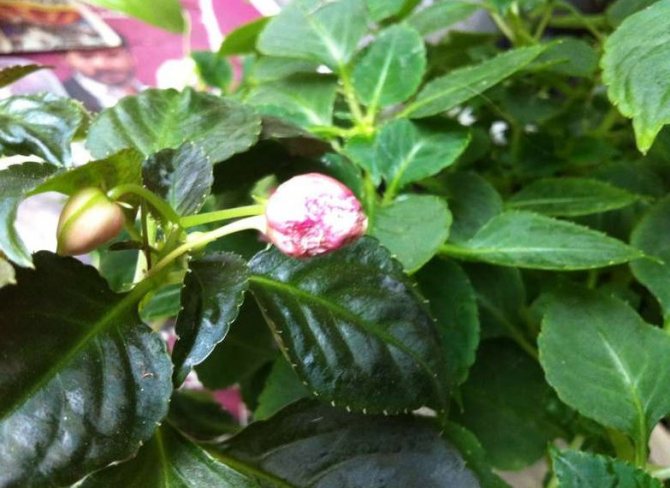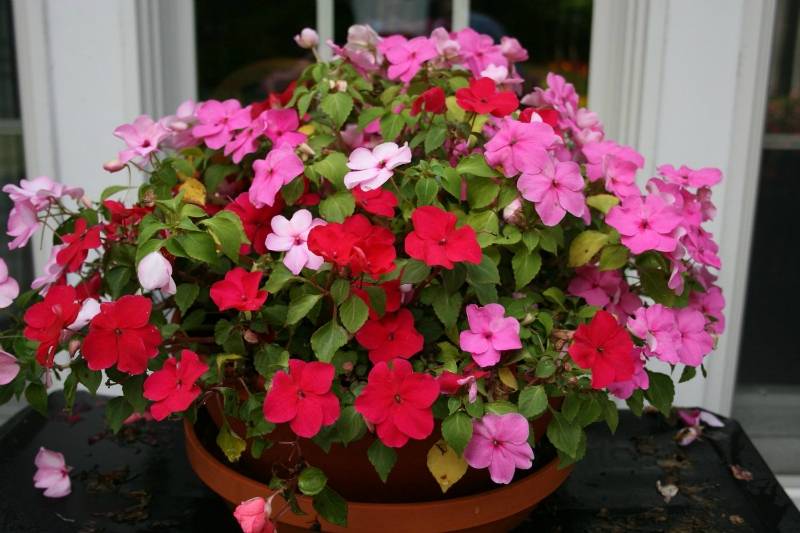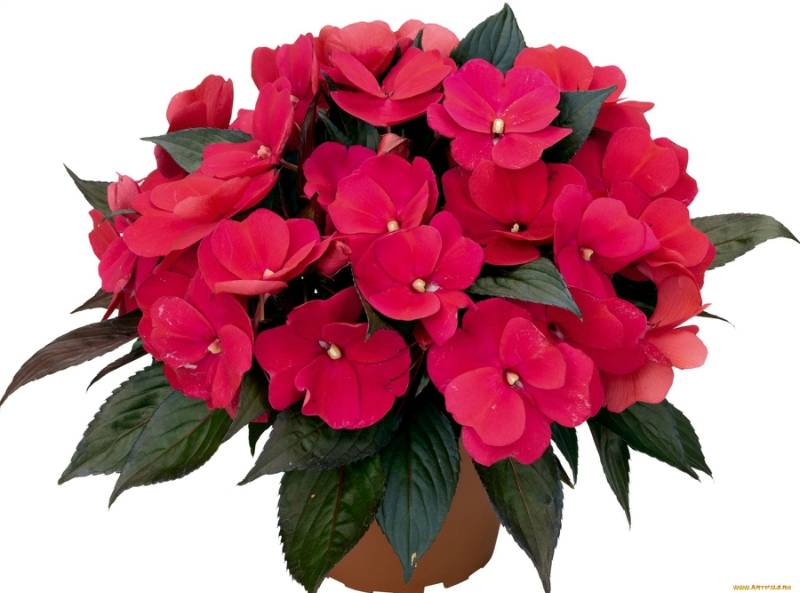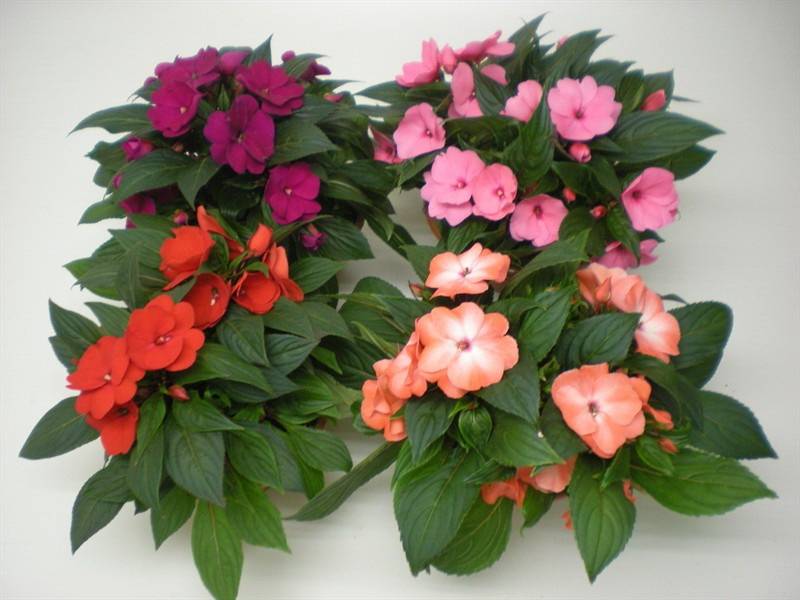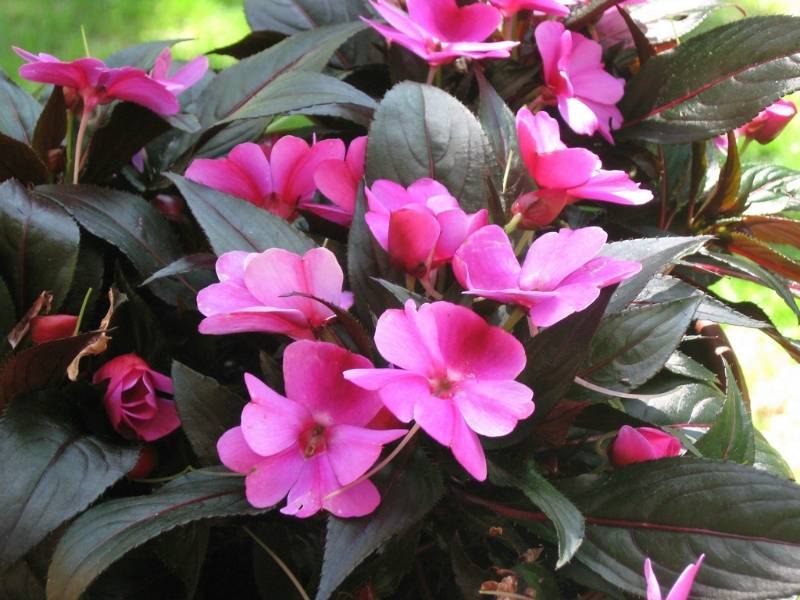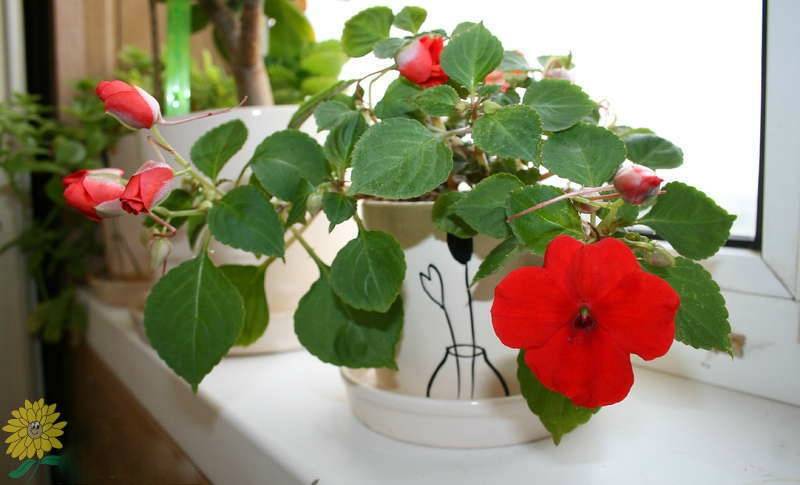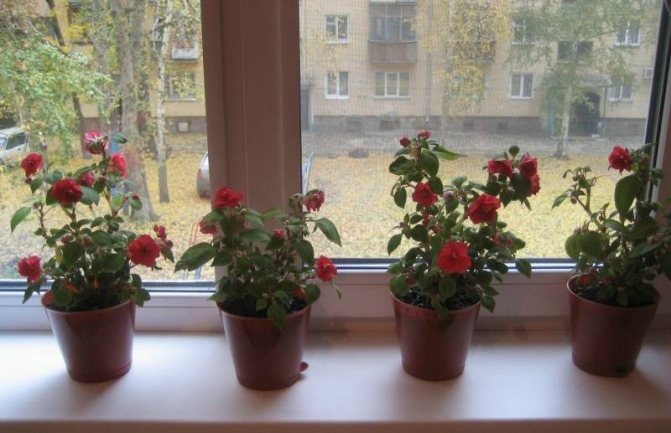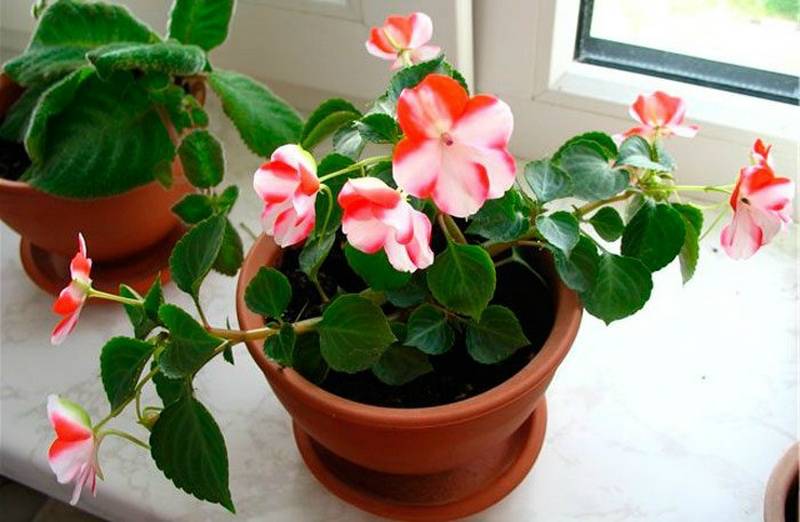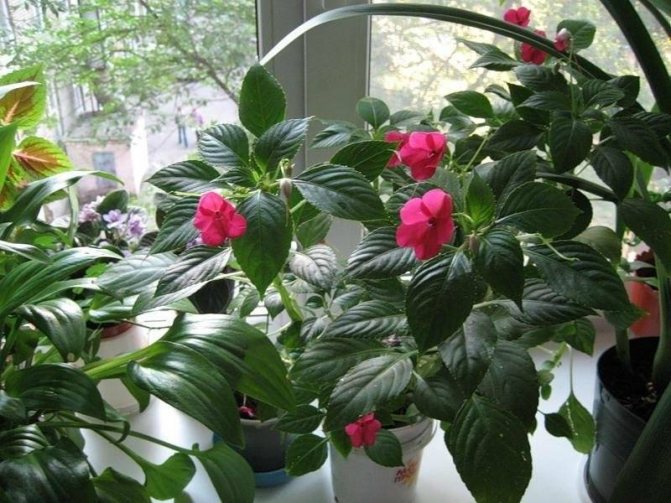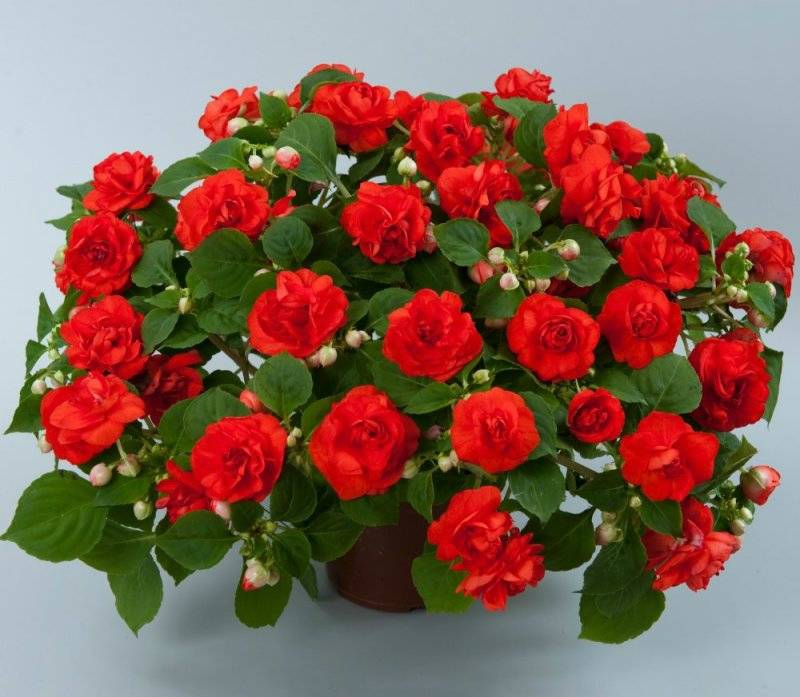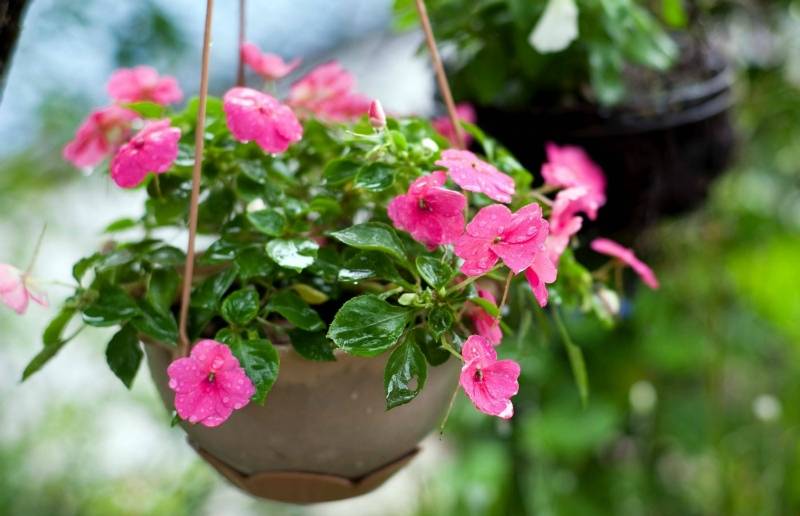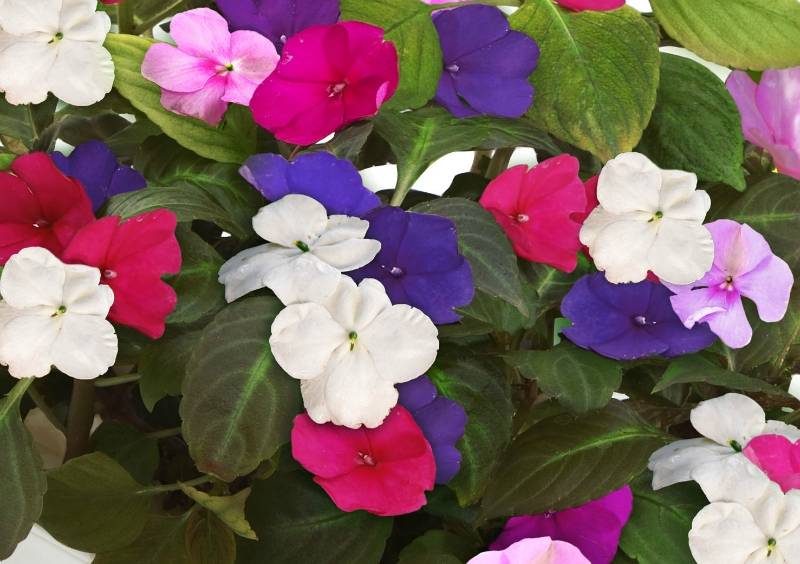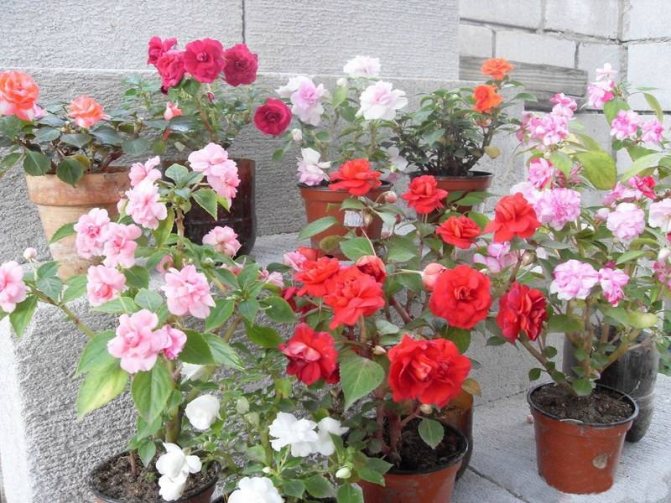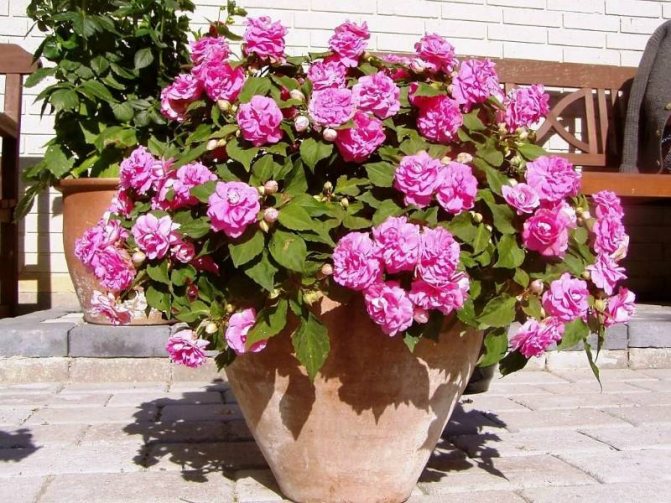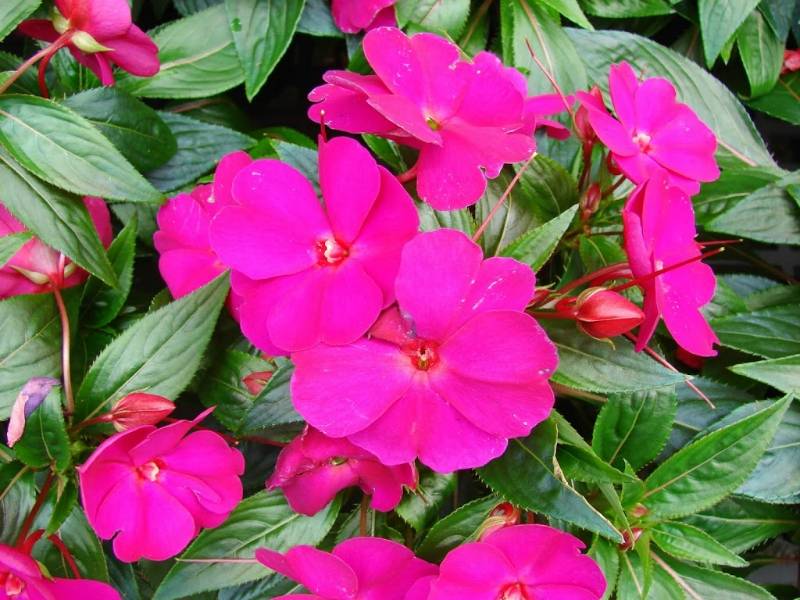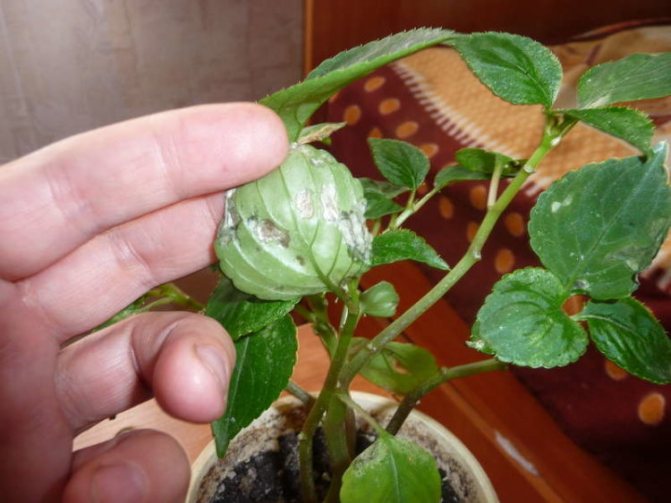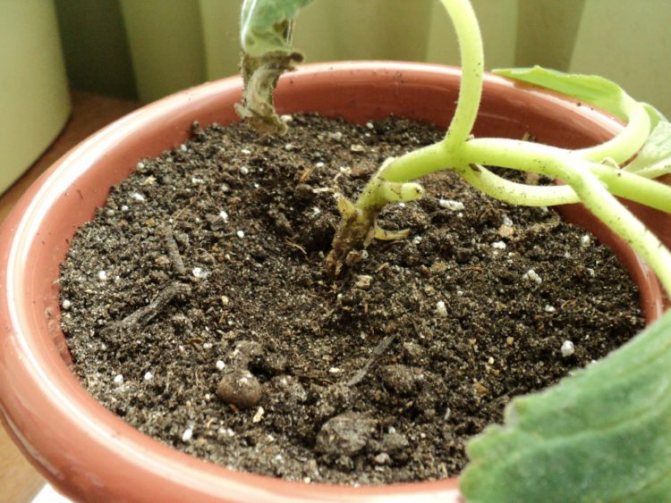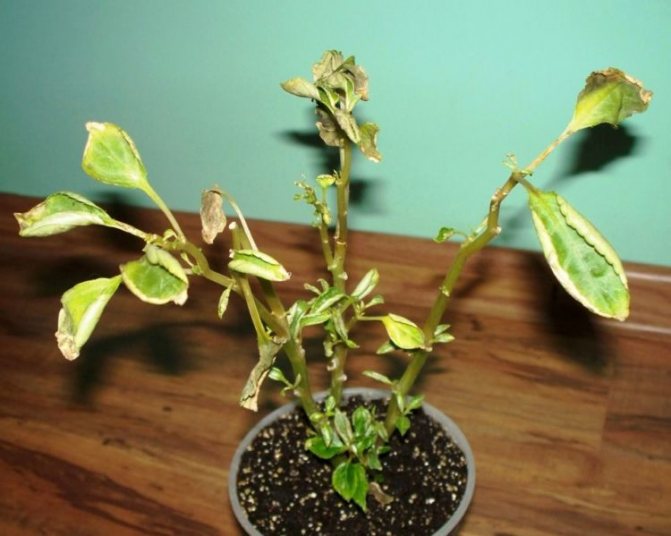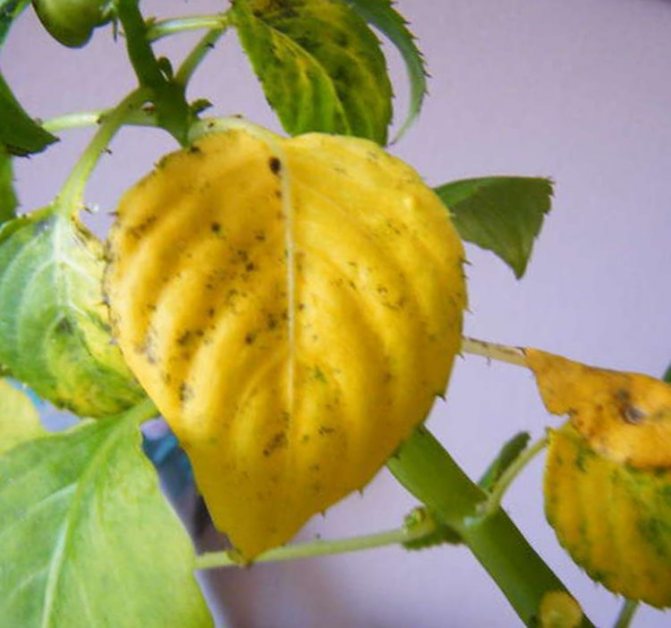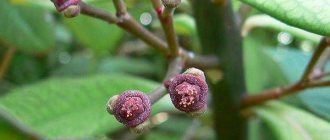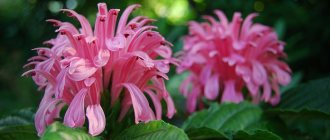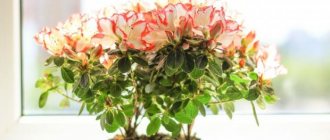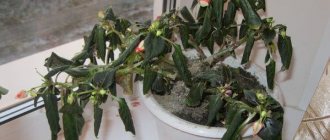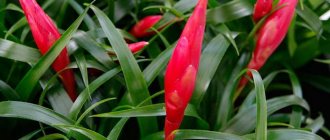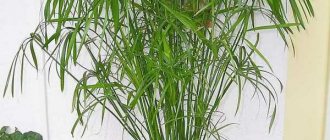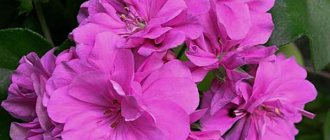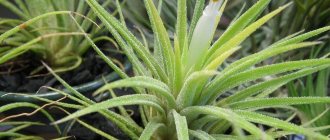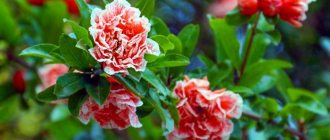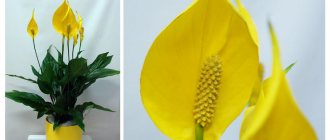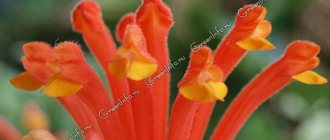»Signs» Signs and superstitions about Vanka Mokrom
0
5914
Article rating
Indoor flowers are not only a decoration in the house, many signs and superstitions accumulated by the experience of more than one generation are associated with them. Believe them or not is the right of each of us, but it is always interesting to learn something new about the plant that "lives" in your home. It will be about the Vanka Wet flower, about which there are also entertaining folk beliefs.
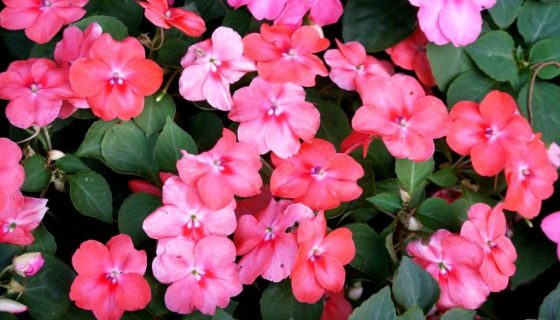
Vanka Wet
Description of the plant and its varieties
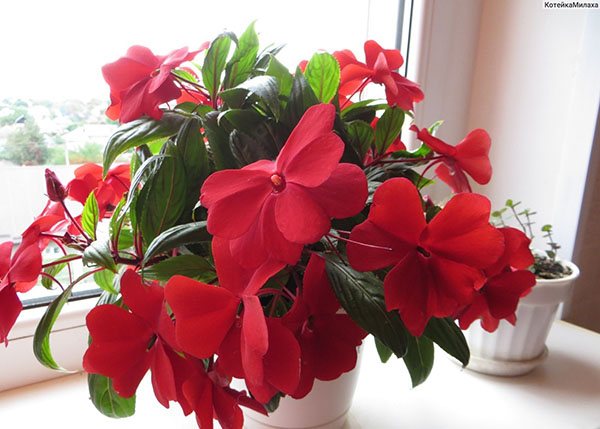

The balsam genus includes about four hundred plant species. Indoor floriculture mainly grows:
- balsam Holst;
- sultan balsam;
- Waller's balsam;
- New Guinea hybrids.
The flowers of the wet vanka are distinguished by a huge variety of shades: from white and pale pink to red and maroon. Plants with bicolor petals are increasingly common. Recently, breeders have bred varieties with flowers that are much larger in size than the usual indoor balsams. At the same time, the bushes of such plants are still compact.
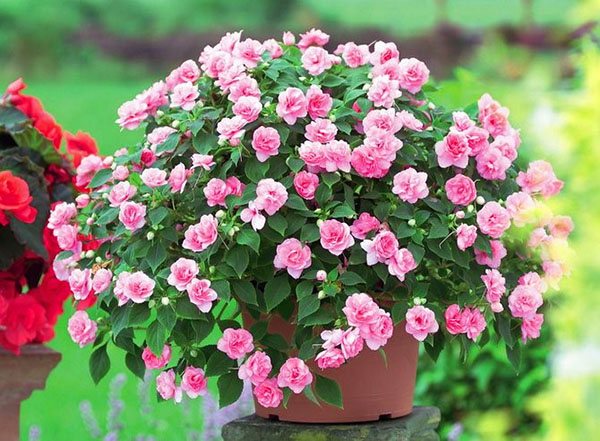

Given the popularity of balsam for indoor cultivation, breeders continue to work on creating new varieties. The hybrids that have appeared recently are striking not only by the size of the flowers, but also by their color and shape. Varieties with double flowers have already become quite common, which look great in landscaping rooms and balconies.
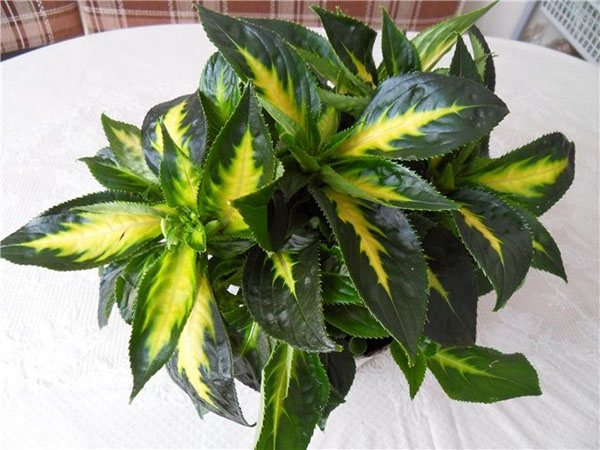

Balsam bushes, densely covered with bright flowers, are very decorative. However, this was not enough for the breeders, and varieties with beautiful variegated leaves appeared. Such plants look very attractive even at a time when the flower buds have not yet blossomed. This can be seen in the photo of a wet vanka with variegated leaves.
Variegated varieties need to create the same conditions as usual. They require the same care, with only one difference: in winter, the temperature of their content should be higher than for plants with solid green leaves.
Common diseases
Even when kept in an apartment, some diseases cannot be avoided. Infections are spread by pests, and the fungus can live in poor-quality soil. The table describes the diseases of balsam and their treatment.
Table - Diseases of balsam
| Name and cause of the disease | External manifestations | Treatment |
| Cucumber mosaic (virus) | - Leaves become wavy; - yellow spots and holes appear | - The plant is isolated and destroyed |
| Ring mosaic (virus) | - Rounded spots with a ring edging appear on the foliage; - growth slows down; - the leaves are cracking | |
| Brown rot (fungus) | - The stem becomes thin at the base, turns brown | - At the initial stages of the disease, they are repeatedly sprayed with the drug "Fitosporin"; - in case of severe damage, the balsam is destroyed |
| Downy mildew (fungus) | - Light spots are formed on the outside of the leaves; - the back of the leaves is covered with a dirty whitish bloom | - Carry out trimming of the affected tissue; - sprayed with "Alet" |
| Bacteriosis (bacteria) | - Black spots appear on the foliage | - Carry out pruning; - repeatedly sprayed with fungicides |
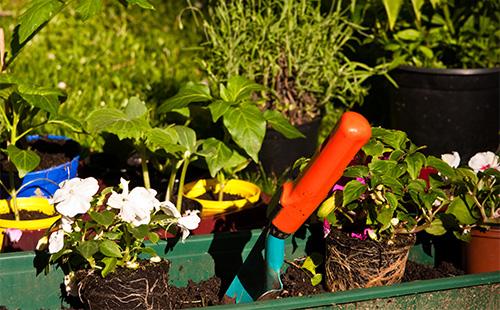

Caring for balsam at home
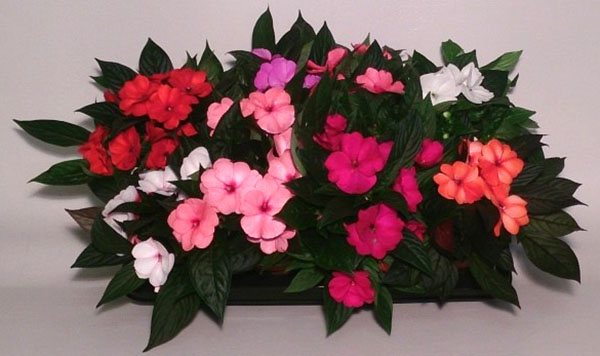

In order for the plant to thank you with lush and bright flowering with the onset of summer, it is important to know how to properly care for this flower. Vanka wet is an unpretentious plant, for its growth and flowering conditions are needed that are not at all difficult to create at home:
- Temperature: The optimum temperature for balsam is about 18 degrees. In winter, you need to make sure that it does not drop below 13 degrees. In summer, the temperature should not rise above 22 degrees. Too hot and dry conditions can cause leaves to curl and fall off.
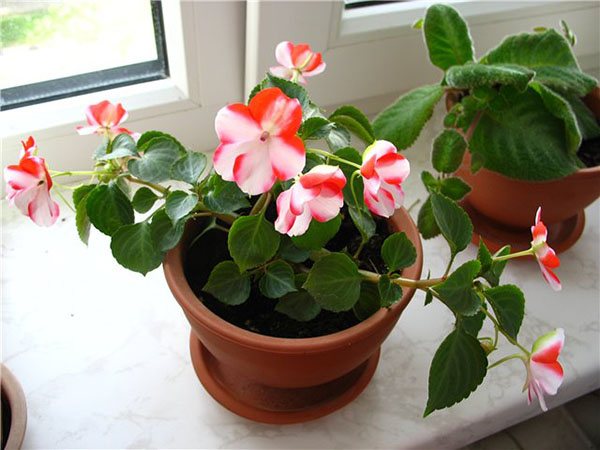

- Lighting: good, but diffused. The plant needs to be shaded from bright sunlight. Avoid placing the balsam pot or container on the sill of the south window. The plant can tolerate some shade, but in this case it will not bloom.
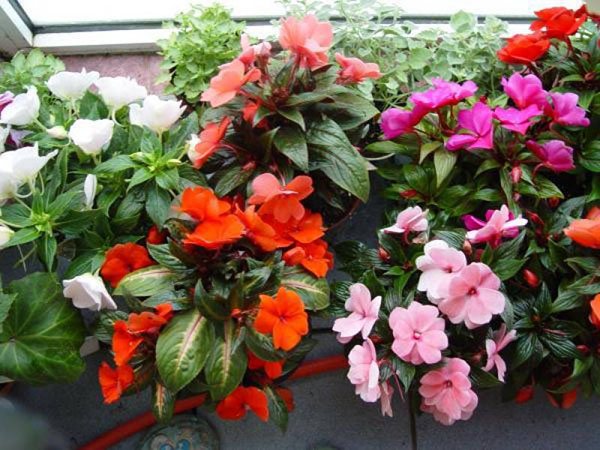

- Watering: In summer, water the plant at least 2-3 times a week is required. In winter, when the temperature drops, watering should be reduced. Usually, in the cold season, this flower is watered once every 7-10 days. Balsam does not tolerate waterlogging, especially in combination with low temperatures. This can lead to plant disease and even death. Allow the soil to dry well before watering again.
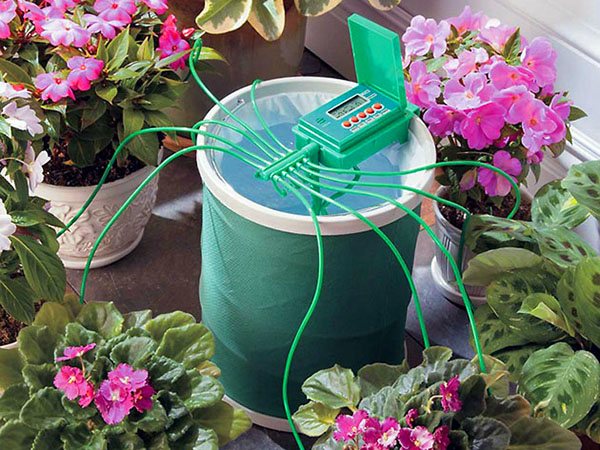

- Soil: for balsam, a loose nutrient mixture is required. A combination of greenhouse and deciduous land with the addition of a small amount of sand would be ideal.
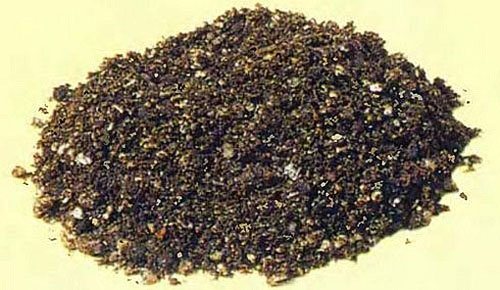

- Top dressing: in the summer, during the period of active growth - once every 1-2 weeks. Top dressing is made with fertilizers for indoor plants, diluted in water. It is recommended to alternate organic and mineral fertilizers.
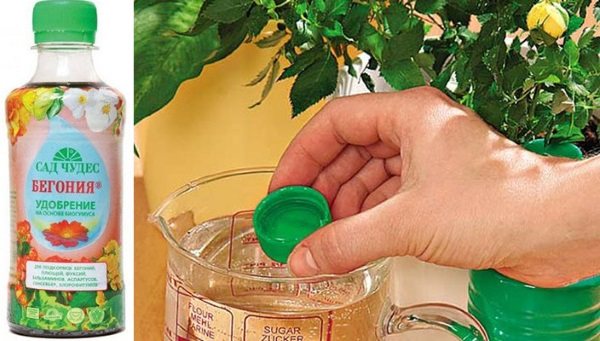

- Air humidity: if the summer temperature reaches 22 degrees, the balsam pot should be placed in a tray with wet pebbles. However, the plant should not be sprayed. This can lead to fungal infections and blotches on the flowers.
- Transplant: After the first year of growth, balsam must be transplanted annually into fresh potting soil. Since the plant is very elongated due to its rapid growth, it is better to grow a new balsam from cuttings every spring.
- Leaf Care: Clean the dust off the plant with a soft brush. In summer, you can shower the leaves and shake off any water droplets. Do not use polish for maintenance, as this may damage the leaves.
If you provide proper care at home, a wet banya flower will thank you with its lush and long flowering.
For fertilizing balsam, use fertilizers at a concentration two times lower than that recommended by the manufacturer.
Caring for Vanka wet: what to consider and how to propagate
Balsam is a relatively easy plant to care for. In an apartment, you can create favorable conditions for it, achieve a long, almost year-round flowering. To do this, you need to adhere to the recommendations of experienced florists.
- Lighting. All balsams love diffused but bright light. Direct sunlight is undesirable - on the southern windows, the plant is protected with tulle. The optimal location is east or west. Balsam responds well to frequent airing of the room or moving to the balcony in warm weather. In summer, planting in the ground is allowed with the onset of stable heat. Balsam does not have a pronounced rest period, therefore additional lighting is required in winter.
- Temperature. Balsam loves warmth, calmly withstands heat up to 30 ˚С. The optimum temperature is considered to be from 20 to 25˚С. In winter, it needs a relative coolness of at least 15˚С.
- Watering. In spring and summer, it is recommended to water immediately after the soil surface dries. In autumn and winter, they adhere to moderate watering - after the surface layer of the soil dries out, they wait two days.They try to maintain stable soil moisture, use warm, settled water.
- Humidity. At temperatures below 22 ° C, balsam adapts to dry air. In the heat, frequent spraying is needed.
- Top dressing. Balanced fertilizers are applied twice a month for beautifully flowering crops. The bulk of dressings falls on the period of active growing season. If flowering continues in winter, occasionally balsam can be fed with a half dose of complex fertilizer.
- Pruning. To preserve decorativeness and stimulate flowering, spring balsam is trimmed, cutting off the stems by a third or half the length. As the lateral shoots grow back, the tops are pinched. Weak, unnecessary branches are cut at any time of the year.
- The soil. The optimal soil for balsam is a mixture of deciduous soil, humus, turf and sand. All components are taken in the same amount.
- Transfer. The most favorable time for transplanting is the beginning of spring. Young specimens are transplanted every year. If necessary, it can be transplanted in the summer. Many flower growers recommend using the transshipment method.
In bulky dishes, Vanka does not bloom wet. To stimulate flowering, the main shoots are shortened, transplanted into a smaller container. When caring for balsam, maintain a stable soil moisture - drying out can lead to the death of flower buds and the fall of buds at the stage of their formation.
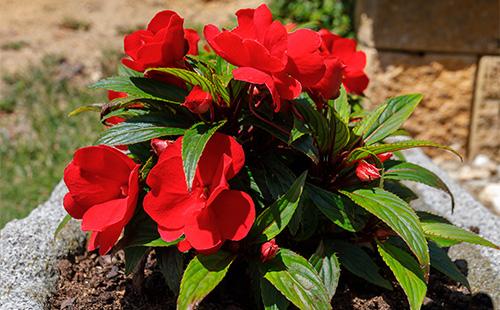

Reproduction of balsam
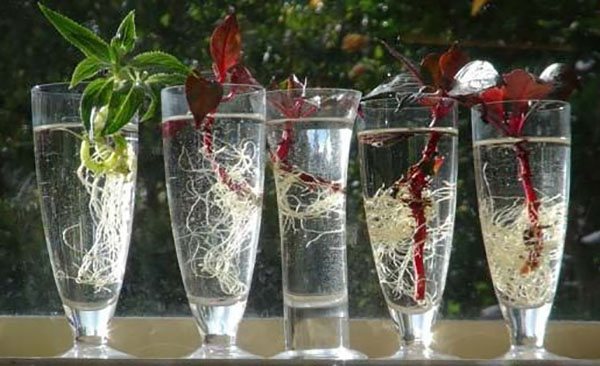

The flower Vanka is wet in spring and summer. Two methods are suitable for its propagation: by seeds and by cuttings. You can buy ready-made seeds or get them yourself from your home plant, but for this you need to take care of pollination. Seeds sprout within two weeks.
It takes about the same time to root the cuttings. As you can see in the photo, a wet indoor flower Vanka can easily take root in water. 3-4 pieces of charcoal should be put into the water for rooting cuttings. Side shoots of a plant about 8 cm long are suitable as cuttings.
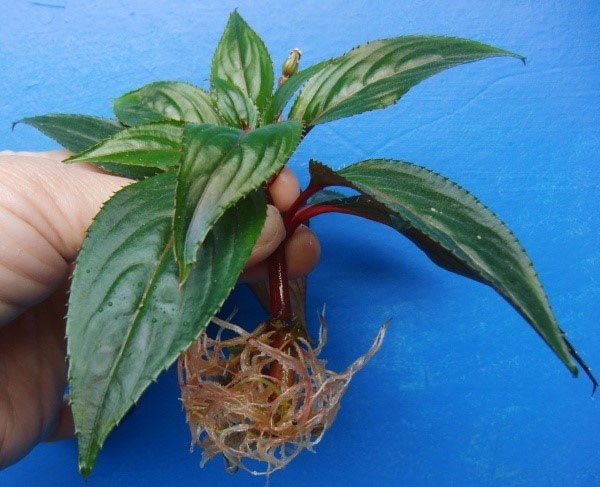

After the cuttings have taken root, they should be transplanted into small pots. For the first time, the transplanted cuttings should be covered with plastic wrap to ensure a high level of humidity.
This plant does not like sudden temperature changes. However, in winter, it is advisable to lower the temperature for balsam to 14-16 degrees, providing the plant with a dormant period.
Popular varieties of balsam
Many varieties of Nedotrog are bred on the basis of Waller's balsam, garden or New Guinea. They differ in color, size and shape of flowers, as well as the height of the bush.
Garden Tom Tamb
This short balsam bush (25 centimeters) is planted in city flower beds and garden plots. The plant has oblong lanceolate leaves, double flowers of various shades (pink, scarlet, purple, snow-white). Tom Tamb is a one-year-old blooming all summer long.
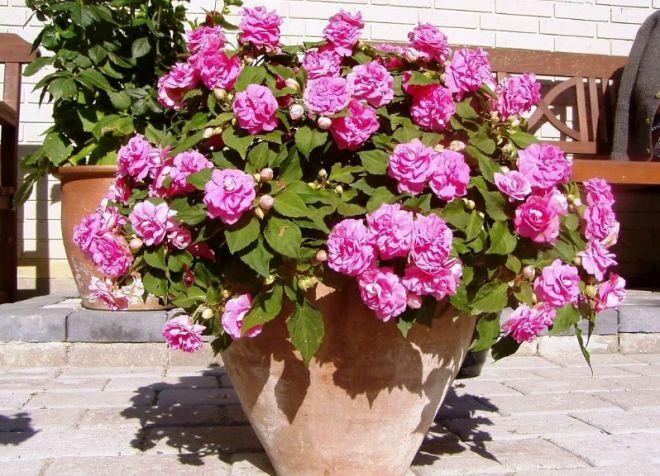

Camellia
Tall and vigorously branching plant. It can stretch up to 61 centimeters in height. The Camellia variety blooms for a long time and abundantly. Flowers - double, pale pink or purple. An annual used for flower bed decoration.
Waller
The touch-me-not Waller is a popular indoor and garden culture. Height - 26-40 centimeters. The bush has a spherical shape, juicy, highly branching stems. Flowers can be simple and double, of various colors. Impatiens blooms for almost 90 days. The variety is often used to breed new hybrids.
Exotic dwarf
A small plant often used to decorate balconies. The height of Impatiens is only 20 centimeters. Leaves are lanceolate, serrate. Flowers can be purple, pink, bright red.
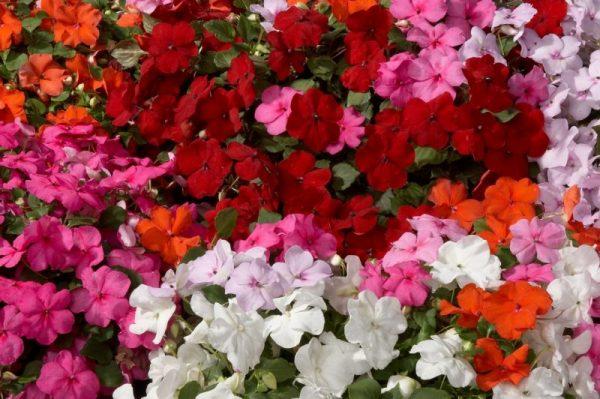

Harmony
A beautiful, compact plant obtained on the basis of New Guinea balsam.Forms a lush bush, strewn with large round flowers on top. This thermophilic plant is usually grown in indoor pots.
Java
Long blooming Impatiens, bred on the basis of New Guinea balsam. This plant has bright, exotic-looking flowers blooming against the backdrop of shiny greenish or bronze leaves.
See also
Description of the Sulange magnolia variety, planting methods and care, pruning and preparation for winterRead
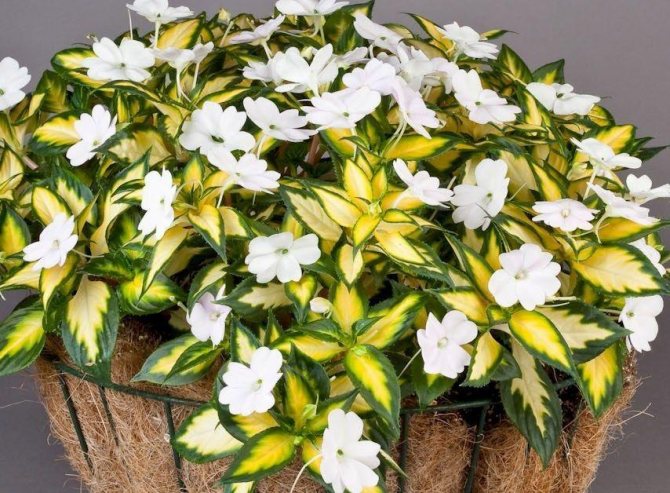

Mini jini
A series related to New Guinea hybrids. Balsam has small dark green leaves and numerous small flowers that cover the bush almost all year round.
Macarena
Balsam from the group of New Guinea hybrids. Impatiens have bright, luminescent, orange flowers and bronze-green leaves.
Camelia flowered
Tall plant. The variety is bred on the basis of garden balsam. It has a high pyramidal stem, oblong leaves, pink or lilac flowers.
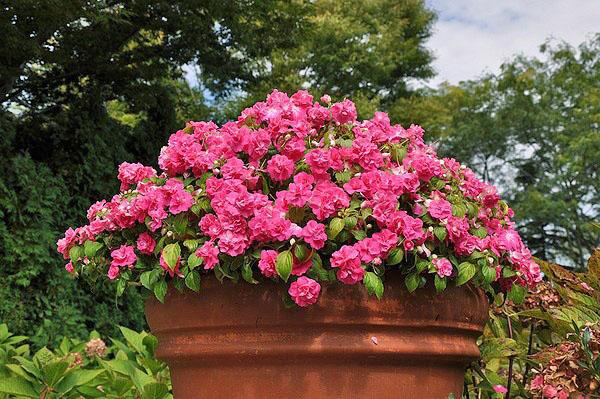

Peppermmint
Erect pyramidal plant, 40-45 centimeters high. Flowers - camellia-like, large, double, can be scarlet, pink, monochromatic or white speckled. The annual blooms in gardens from June to September.
Baby bush
Low-growing garden plant. One-year-old, reaching 25 centimeters in height. Blooms for a long time with large pink-like flowers.
Tom thumb
Dwarf garden variety. One-year-old blooming all summer long. Flowers - terry, can have snow-white, pink, scarlet, lilac color.
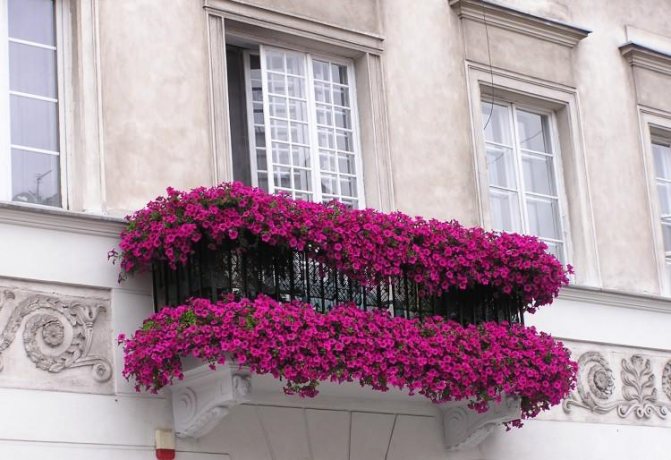

Scarlett
Garden culture, 26-40 centimeters high. Abundantly covered with flowers from June to September. The color of the petals is bright red.
Sultanoid
Indoor culture 31-61 centimeters high. Leaves are green with serrated edges. The flowers are similar in shape to an orchid, are located one by one on a long stem, have a spur, are white, reddish, pale pink. In an apartment, Impatiens can bloom throughout the year, flowers replace each other, each blooms for about 2 weeks.
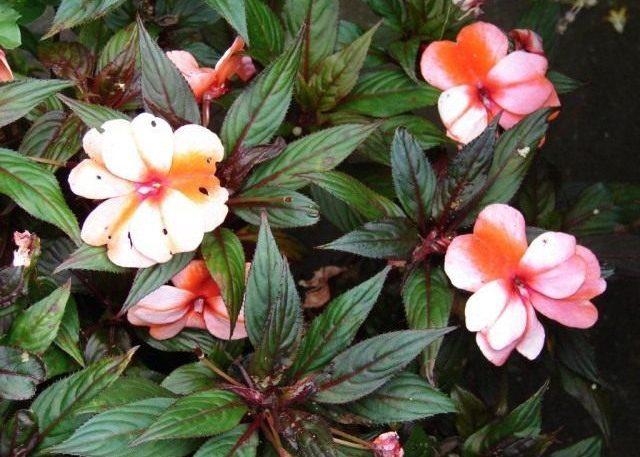

New guinea
It is more often grown as an indoor perennial. The plant is tall but compact. It grows up to 30-45 centimeters in height. It is characterized by abundant and long flowering. Requires long daylight hours and high temperatures. It has large double flowers, mostly pinkish and scarlet.
Terry
Indoor culture with dark green shiny leaves and large double flowers. Touch-me-not blooms almost all year round. Flower petals can be pink, scarlet, snow-white, solid or variegated.
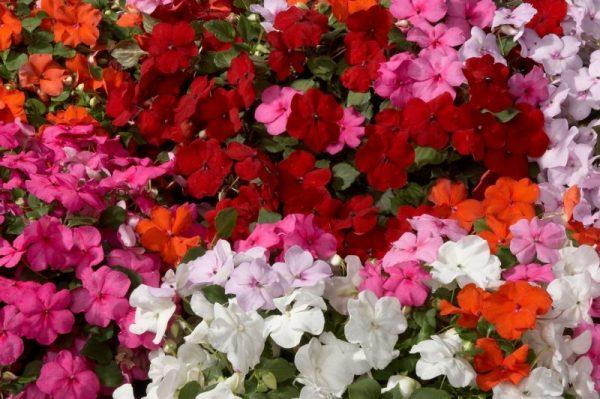

Garden balsam
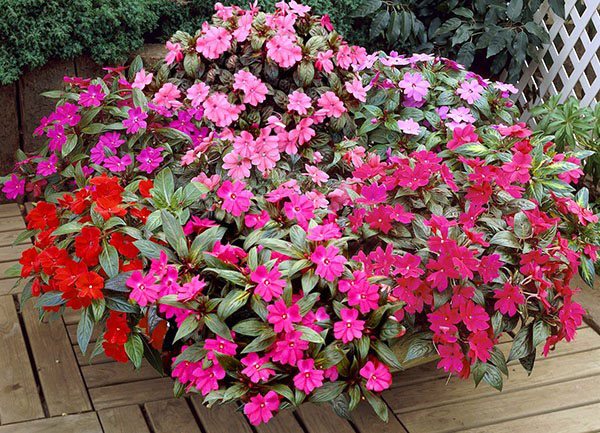

Unpretentious balsam - Vanka wet is also used in decorative and home gardening. At the same time, plants of familiar indoor varieties are often used for landscaping areas and landscape design, planting them in containers or open ground.
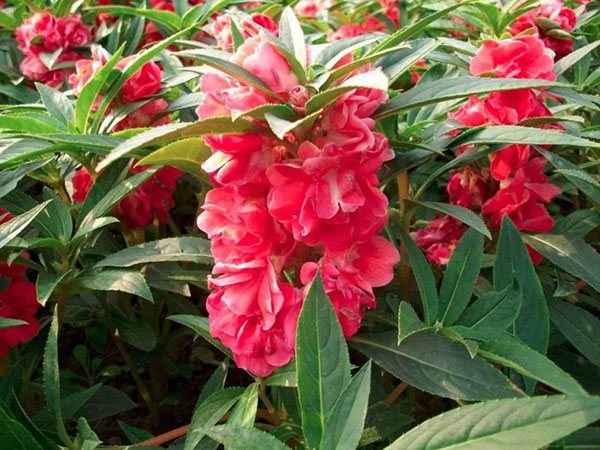

Along with the houseplant Vanka wet in landscape design, an annual form is also used, which is called "garden balsam". This plant spread from East India, where it is found in the wild. It has a lush erect bush with juicy fleshy shoots and green toothed leaves.
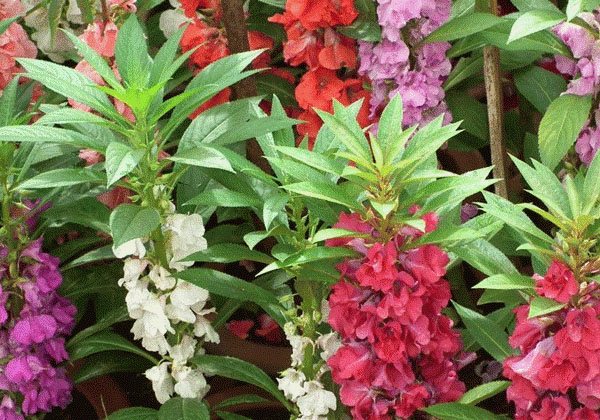

The plant blooms for a long time and abundantly. The flowers of Vanka wet can be simple or double. They are distinguished by a wide palette of various shades. This thermophilic plant requires a well-lit area. Garden balsam is propagated by seeds.
Often, signs and superstitions are associated with a indoor flower Vanka wet. They say that it has a positive effect on creative people, contributes to the creation of an atmosphere of harmony and harmony in the house. If peace and respect reign in the family, this flower will bloom magnificently and lastingly. Misunderstandings and disagreements between family members, on the contrary, can affect the plant negatively.
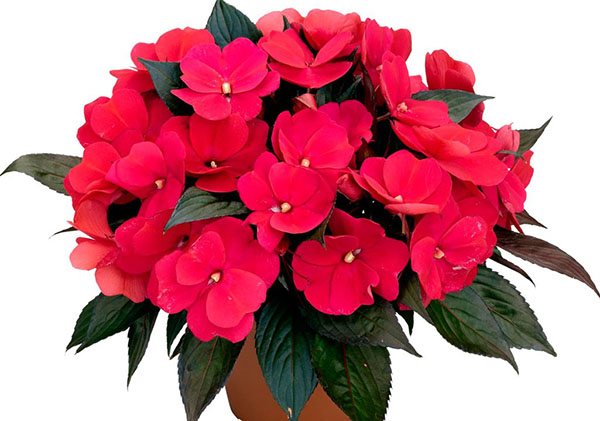

Vanka wet got its name because of this feature: often droplets of juice appear on its juicy green stems. Probably for the same reason, the superstition arose that because of the flower, family members could become addicted to alcohol.
How these facts are related is not clear. And, of course, it is everyone's business to believe in such signs or ignore them. But in favorable conditions and a sincere home atmosphere, the balsam will bloom and prettier day by day, delighting households with the bright lights of their flowers.
Video about a wonderful plant
Balsam Vanka is considered a fairly well-known flower in the post-Soviet space. This flower was brought to Europe in 1596 and has been growing on all our windowsills ever since. As soon as they do not call him - Balzamin, Impatient, Vanka-wet. And among the people, this flower has another common name - "light". Its type is characterized by lush greenery and very pretty flowers, the color palette of which ranges from light pink to dark red. The very sight of such a plant evokes a smile and high spirits. How to take care of and what you need to protect from, will be discussed in this article.
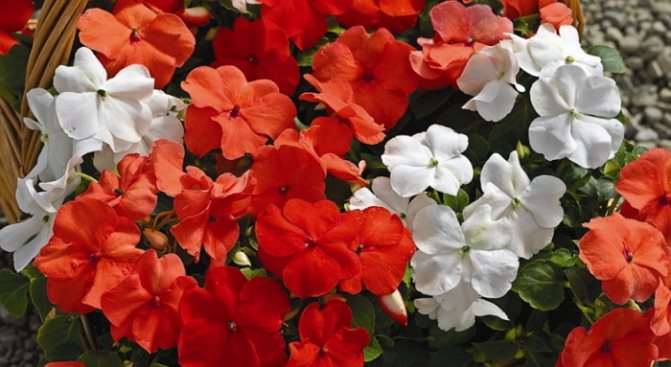

Human exposure
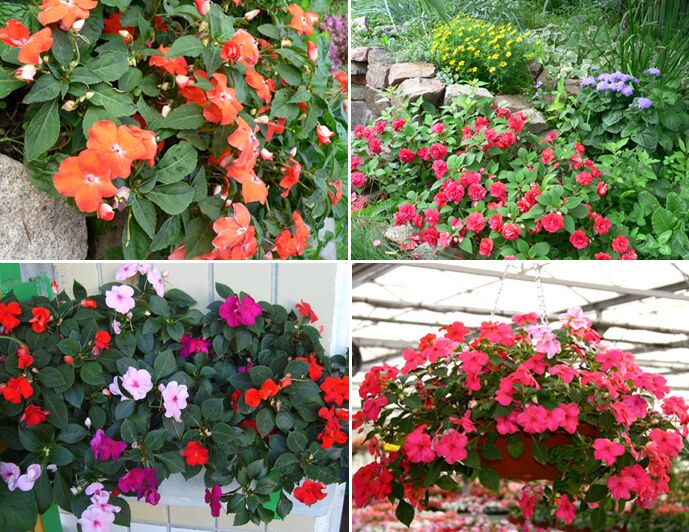

Multicolored Balsam
There is an opinion that the Spark flower inspires a person, an unprecedented amount of mental strength appears, which pushes the owner of the flower to develop, to move up the career ladder. The person himself does not understand what is happening to him, just at one fine moment he catches himself thinking that he has become more energetic and active.
Description and varieties
The genus Balsamin (Impatiens), or touch-me-not, is represented by annual or perennial herbaceous plants of the genus Balsamic, growing naturally in the tropics of East Africa and India, in Ceylon, New Guinea, in the temperate regions of Asia.
The touchy family is named due to the fact that a box with ripe seeds, with a slight touch to it, bursts with a crash and scatters the seeds far (up to 2 m) around itself.
In Russia, for its rich and long-lasting flowering, this indoor flower is often called "Ogonyok". In addition, flowers are called "Vanka-wet" for their love of water. Indoor balsam is one of the most famous undemanding houseplants.
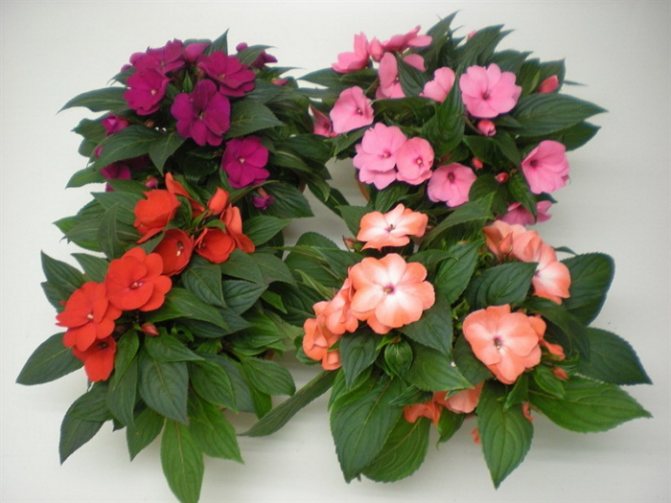

What the plant looks like:
This flower looks like a spherical shrub with a height of 20 centimeters to 2 meters, it directly depends on the species.
- Stalk contains many succulent and translucent branches, on which fleshy leaves grow, with waves along the edges. Painted in malachite or reddish color. There are types of balsam, the leaves of which have a terry surface.
- Flowers Balsam surprises the eyes with an abundance of alternatives in colors and shades, from white and pale pink to exciting reddish. The scarlet variety was called the "fire". Delicate flowers with spur-like processes envelop absolutely the entire plane of the shrub during the flowering period.
- Seed boxes such a plant, true touch-ups, when touched, they open, and the seeds that are in the center scatter in all directions.
Varieties and varieties
According to various sources, the size of the balsam family ranges from 400 to 550 varieties. Particularly common are classic varieties, which are spreading bushes with scarlet and snow-white flowers.
Over time, various hybrid varieties began to displace them - they differ in the smallest, densest bushes, with rich flowering, new colors. Variegated (variegated) plant types belong mainly to New Guinea hybrids. Four options are more common.


- Waller's balsam... The species has several hybrid varieties with similar characteristics. The height of the bush reaches up to half a meter or slightly higher. Shoots glabrous, decently branched, thick. Thin leaves are attached to long stalks.The flowers are separate, large, located at the ends of the shoots. The color is varied. Terry forms collide.
- Balsam Peters. A very tall, bushy plant. Slightly pubescent shoots. The color of the ground part has a bronze tint. Bloody flowers, on high stalks.
- Balsam of Niamey. A bush up to a meter tall, with tall, branchy shoots. Leaves are elongated, densely placed on the stem. Buds on tall pedicels fold in leaf axils. The flowers are mostly red. Two-tone varieties with the addition of yellowish blotches collide.
- New Guinea Balsam. Contains a group of tall and compact perennials. Flowers of different shades, leaves are large enough.
Botanical description
Indoor flower Ivan wet grows up to half a meter in height. Its stems are erect, branched, smooth. Leaves are oval or lanceolate, with small teeth at the edges. The foliage is purple-bronze or green.
The buds are laid in the leaf axils. In culture, there are varieties with a wide variety of colors, with the exception of a blue tint. The flowers are simple or double. After pollination, green fruits are tied, as they ripen, they turn into a dry seed box.
Why is the flower called that and what is the correct scientific name? The home flower Vanka wet has other names. All of them are due to the properties of the plant. If you touch a ripe seed pod, it will immediately open the shutters, shoot seeds. For this balsam impatiens was nicknamed "touchy". Another name - "light" - is associated with a bright and abundant flowering.
In the reviews, experienced florists write that balsam does not tolerate tightness on the windowsill. It grows much better on its own, without being adjacent to other plants.
Planting and reproduction of the flower "Vanka wet"
Gardeners use seed and vegetative propagation. That one, that another method is effective, but sowing seeds from a hybrid plant can provide sudden results - the main characteristics of the species change. For the purchase of seedlings of a particular type, purchased seeds are usually used.
Seeds
The right time for seed reproduction is spring. But if you sow the seeds in February, you can get a graceful flowering plant as early as May. A mixture of sand and peat is used as a substrate. To acquire strong seedlings, specific priorities are followed.
- Seed preparation. The planting material is moistened for ten minutes in a weak solution of potassium permanganate, rinsed and poured with warm water for an hour. The seeds are slightly dried.
- Landing. The vessel is filled with a previously prepared substrate. Seeds are divided along its plane, sprinkled on top with a thin layer of fine sand. Cover the container with plastic wrap.
- Germination conditions... Provide a stable temperature level in the range of 18-20 ˚С. Once every two days, the greenhouse is opened, excess condensate is removed, and the soil is moistened from the sprayer as needed. If possible, place an auxiliary light illumination.
- Picking. As a result of the appearance of several full-fledged leaves, the seedlings are allowed to be planted in individual small pots.
- Topping. At the stage of five to nine leaves, the young plant is pinched to activate branching.
Cuttings
Reproduction of Vanka wet by cuttings makes it possible to easily grow a young plant to replace the old one. Cuttings are cut deliberately or the crown shoots left at the end of spring pruning are used. Rooting is performed in the following order.
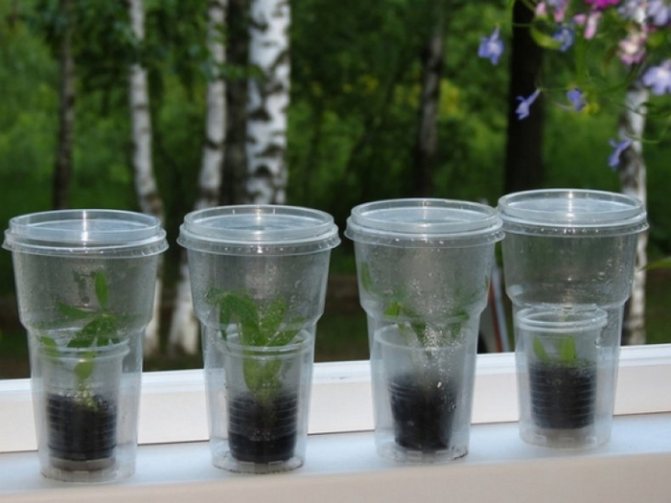

- Preparation of cuttings. The best cutting length is 5-6 cm. The upper leaves are cut in half, the lower ones are cut off entirely.
- Extension of roots. The cuttings are placed in water with the addition of activated carbon capsules and a root former.
- Landing in the ground. Subsequently, the appearance of the roots, the cuttings are placed in a simple soil.A week is stored under a film to equalize temperature jumps, maintain stable humidity.
- Topping. In a young plant, the growth point is pinched to stimulate branching.
The bush can be created much more magnificently if a couple of cuttings or seedlings are planted directly in one flowerpot. Between plantings, it is required to maintain a gap of about 5 cm. Florists advise planting seedlings of the same type in a common pot.
Conditions for growing a flower in the garden
Balsam is a thermophilic culture. Seeds, seedlings or ready-made purchased plants are planted outside at the end of May. Most often, gardeners grow balsam in a seedling way. Seedlings grown in room conditions are transplanted to a flower bed at the end of May, when the threat of night frosts has passed, and the air warms up to 20 degrees Celsius. At a temperature of 5-10 degrees above zero, the plant may die.
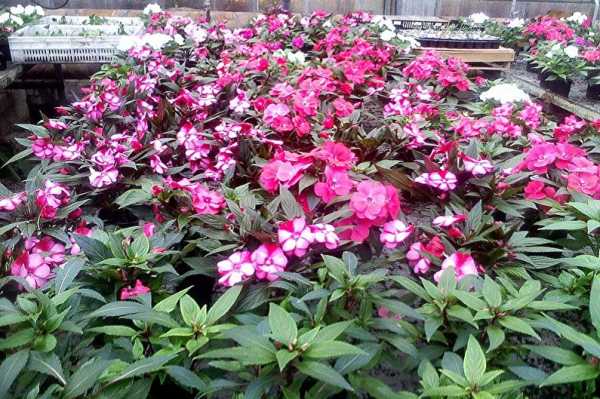

First you need to prepare the soil for the flower bed. Balsam grows on neutral, fertile, loose, light soil. The soil must pass water well. On clay, acidic and heavy soil, balsam will quickly wither. For Vanka Wet, soil is suitable, consisting of garden, leaf, turf soil, mixed with peat, sand and humus in equal amounts.
Weeding
A flower bed must be constantly looked after. Remove grown weeds, loosen the ground, break up the soil crust. You can mulch the ground with sawdust. Weeds will not be able to break through from under the layer of mulch.
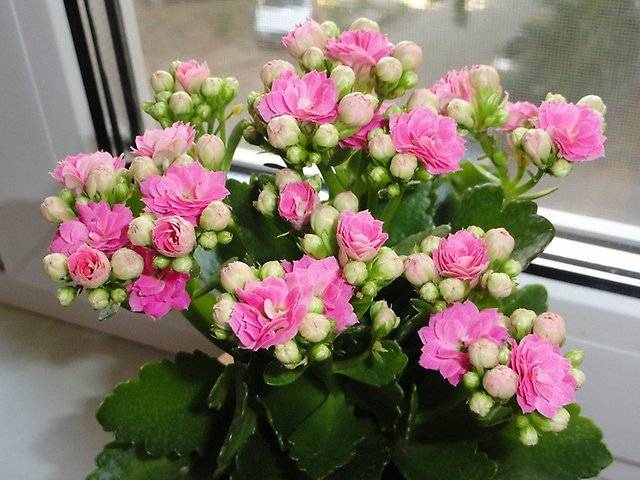

Top dressing
Impossible to feed once every 2 weeks. At the very beginning of development, nitrogen fertilizers are applied to the soil. During the flowering period, the soil is fed with potassium and phosphorus additives. For balsam, complex fertilizers for flowering plants or feeding for geraniums are suitable. For 1 square meter of the plot, you need to dilute 30 grams of fertilizer in 10 liters of water.
Watering
Roly Wet needs to be watered regularly. Do not allow the soil to dry out. With insufficient watering, the balsam withers quickly. However, it is also not recommended to flood a flower bed. In highly moist soil, the plant will begin to rot.
It is advisable to spray the leaves of Impatiens with cold water. Thus, you can protect the bushes from spider mites and aphids.
Illumination
Vanka Wet prefers open, sunny places. It is desirable that the plant is in partial shade in the midday heat. Balsam blooms beautifully under trees with a sparse crown or on the northwest (northeast) side of the house. Balsam has very fragile stems that break in a strong gust of wind. It is better to plant the plant in places protected from drafts and wind.
Vanka wet - home care
At home, balsams need systematic moistening without stagnant water and feeding twice a month with alternating low concentration absolute mineral fertilizer and mullein infusion (1: 10). In winter, the need for watering decreases, it is recommended to fit the balsam into a cool, bright room with a temperature of about 15 ° C.
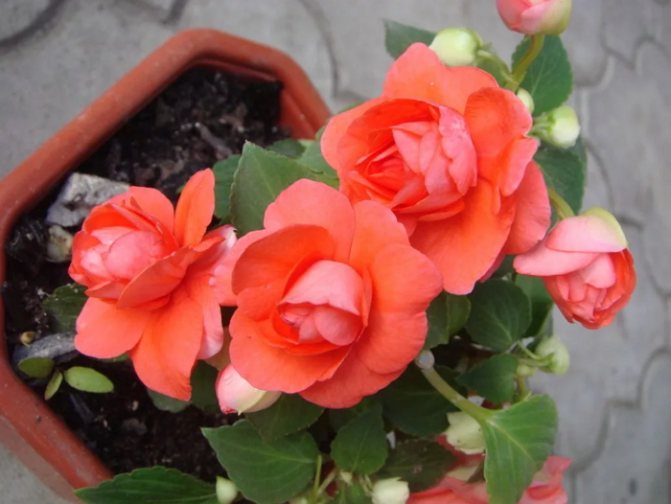

When caring for a plant, constant plant transplantation is required - as a rule, this is done in the spring, but if necessary, it is possible to transplant during the summer. It must be remembered that the plant blooms profusely if it is a little cramped in the pot. Young plants are planted annually, and they can not be transplanted, but transshipped. Adults (usually no older than three years) either transplant balsams or regenerate by cutting and rooting the crown cuttings.
Top dressing
In autumn and spring, it is required to feed Vanka-wet with potash mineral fertilizers. This is considered an important condition, especially if the grower is interested in the subsequent reproduction of balsam. For flower propagation, seeds and apical cuttings are used. To grow blooming balsam by May, the seeds must be sown in January and an additional light source installed.
The cuttings take root faster, practically in a month. So, for example, balsam taken out of cuttings in spring blooms in early summer, and from summer cuttings in early winter.
It is advisable to update the testis from time to time. This is due to the fact that at the end of the appointed time and as the balsam wilts, the balsam is exposed and gets an ugly look. For hybrid flowers, this is not considered a necessary circumstance, as they branch out remarkably.
Watering the plant
This plant is called a water-bread. It is moisture that becomes one of the most important points when caring for this flower. A moisture defect can lead to wilting of leaves and sprinkling of buds and flowers. You can restore a dry plant with a lot of watering.
- In the summertime, moisturizing should be done once every 2 days.
- And in winter - 2 times a week.
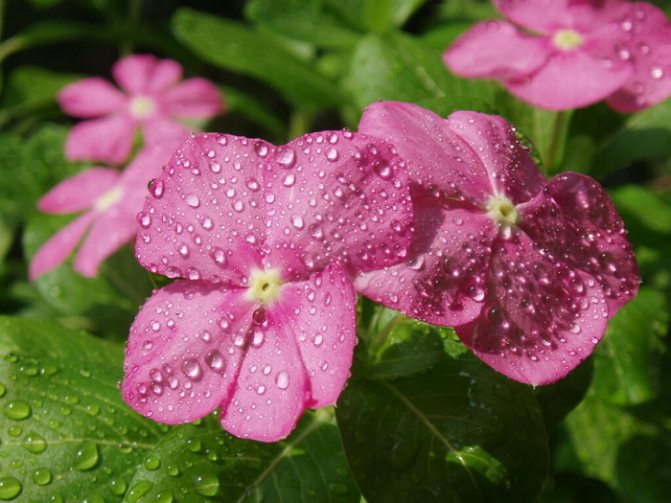

It is possible to water so that part of the water falls into the sump. She will quickly leave that place after a certain time. The safest choice for such a ceremony is pots with deep trays.
If you allowed the plant to dry, then water it thoroughly. This will restore it. But it must be remembered that such experiments have a negative effect on the plant and weaken it. The soil must be regularly moist. But you should also not bring unnecessary water to stagnation, because this can cause tiny flying midges.
Lighting and temperature
This flower is ranked among light-loving plants. It is necessary to be scrupulous with the penetration of direct sunlight. It is advised to shade the plant from the bright sun. But in winter, the required amount of light should be provided for its standard development. Actually, the presence of bright lighting allows new colors to form.
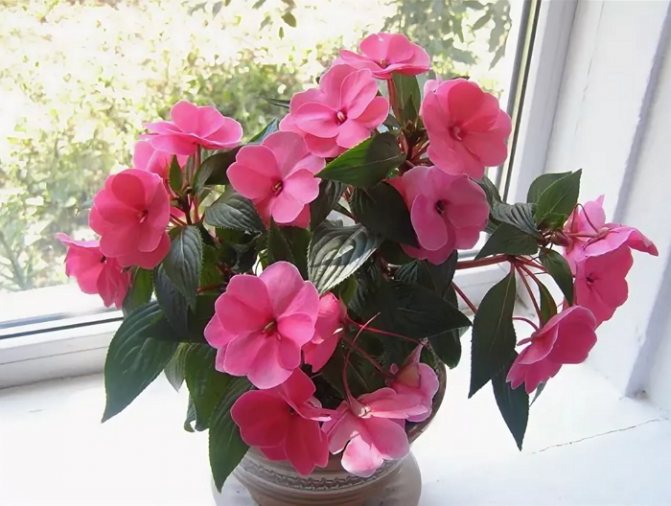

A convenient temperature for this plant is considered to be the interval of 10-16 degrees in the winter time, and 18-20 degrees in the summer. Higher temperatures are not considered critical for him, but only if there is sufficient humidity.
Diseases and treatment
Homemade balsam is attacked by parasites, sometimes problems are formed with improper care.
Vanka wet - a flower and its diseases:
- Whitefly and spider mite are the main parasites of balsam. Their occurrence is preceded by improper care: dryness, heat, lack of fresh air. Getting rid of parasites is favored by the normalization of the flower breeding criterion. With multiple lesions, the bush is sprayed with insecticides;
- Bacteriosis is detected by dark spots on the foliage. Treatment with special preparations such as "Alirina" is required;
- The cause of the origin of fungal diseases is excessive watering of balsam. They are saved from mold and mildew by transplanting into a new container with a new substrate and competent drainage, after which it is worthwhile to thoroughly observe the watering order;
- Gray rot on the plane of the soil. If it occurs, the upper tier of the earth must be removed and replaced with a fresh one;
- Often, balsams begin to turn yellow, curl and fall off the foliage. This happens due to a lack of heat, light, and space in the pot. Care should be eliminated and the plant transplanted into a large flowerpot;
- Due to a lack of light, the use of an extremely large pot, an excess of nitrogenous fertilizers, balsam is able to stop blooming. It is necessary to move the vessel to the most well-lit place, transplant the plant into an appropriate pot and apply a different top dressing (with potassium and phosphorus).
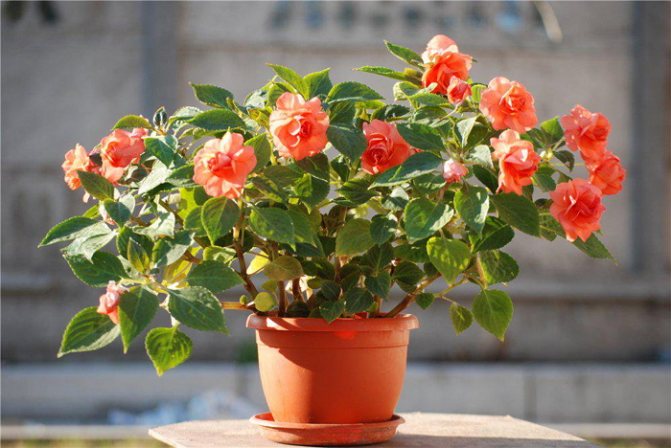

Wet flower Vanka does not tolerate the smell of tobacco. There is sufficient sensitivity to it, so smoking near the plant is not recommended.
Frequent pests
Balsam is susceptible to attacks by many pests of indoor flowers.Mushroom mosquitoes, aphids, and spider mites are especially dangerous. More detailed information on pests is given in the table.
Table - Pests of balsam
| Pest | Symptoms | Control methods |
| Spider mite | - Yellow specks appear on the foliage; - balsam withers away, becomes covered with cobwebs; - the upper leaves are deformed | - Balsam is treated with soap, rinsed under a warm shower; - often sprayed; - increase the humidity in the room; - processed by means of "Aktellik", "Aktara" |
| Whitefly | - Leaves are deformed; - the plant turns yellow, withers | - The bush is washed with warm water; - hang up special glue traps; - sprayed with drugs "Mospilan", "Fufanon", "Confidor" |
| Thrips | - Leaves lose their shape, discolor, acquire a silvery hue; - brown spots appear on the back side; - holes are formed on the petals; - pollen falls off | - Repeatedly, with weekly breaks, sprayed with insecticides "Fitoverm", "Vermitic" |
| Aphid | - Colonies of sedentary insects appear on young shoots; - leaves curl, discolor; - flowering stops; - the plant withers, withers | - Treat all damaged shoots with soap; - sprayed with infusion of needles, tobacco dust; - in difficult cases, the drugs "Actellik", "Karbofos" are used |
| Shield | - Brown plaques appear on the stems; - individual shoots die | - The shield is removed with an alcohol napkin; - the plant is sprayed with any insecticide, covered with a bag at night |
| Puffs | - Balsam withers, stops growing due to damage to the root system | - Water the soil with the preparation "Thunder" |
| Sciarids (mushroom gnats) | - Small midges that look like mosquitoes fly over the flower; - the plant dies due to damage to the root system by larvae | - Balsam is transplanted with soil replacement; - the soil is spilled with the preparation "Mukhoed"; - aerosol "Raptor", "Dichlorvos" is sprayed around the plant |
If you properly care for the flower Vanka is wet, then the likelihood of infection with pests and diseases will be minimized. In favorable conditions, balsam will bloom almost all year round.
Description of the plant and its varieties
Vanka belongs to the genus Balsam, in the list of which there are about 400 species of plants. Lovers of flower growers mainly grow indoors such types of balsam as:
- Holst.
- Waller.
- Sultansky.
- New Guinea hybrids.
Flowers with a varied palette of shades give the plant a special charm. They can be from light pink to dark red colors. You can also often find balsams, the petals of which are painted in several colors.
Modern breeders are constantly working on the development of new varieties of the plant. So, in recent years, many large-sized flowers have appeared. Moreover, the bushes remain small, which makes it possible to grow them on windowsills.
Also popular are plant varieties with double flowers. Loggias and rooms decorated with such hybrids look great. This houseplant, thanks to its many bright flowers, looks very beautiful and decorative, as shown in Photo.
Continuing to work on the development of new varieties, the breeders went even further: they created a plant with variegated leaves. Such Roly wet flower attracts the eyes of people even when his buds have not yet opened.
Interesting! New variegated plants require little maintenance. They are grown under the same conditions as with pure green foliage. However, in winter for variegated balsam, the room temperature should be slightly higher than usual.
Views
There are over 500 types of balsams. Plants vary in height, color and flower shape. Indoor and garden balsams are divided into 3 groups.
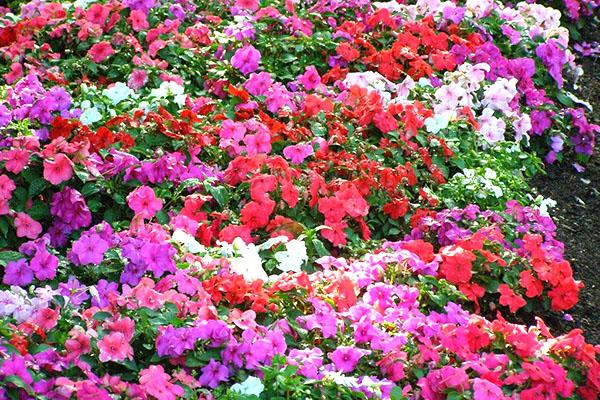

Touchy groups:
- First.
This group includes traditional varieties of Waller's balsam.They are grown in pots, greenhouses or garden beds. This species is represented by various varieties and interesting hybrids. Flowers are simple or double, snow-white, pinkish, purple, reddish.
- Second.
This group includes heterotic hybrids (F1). They appeared as a result of breeding work with the Impatient Waller. Hybrid varieties are represented by perennial compact bushes that bloom profusely for almost a whole year.
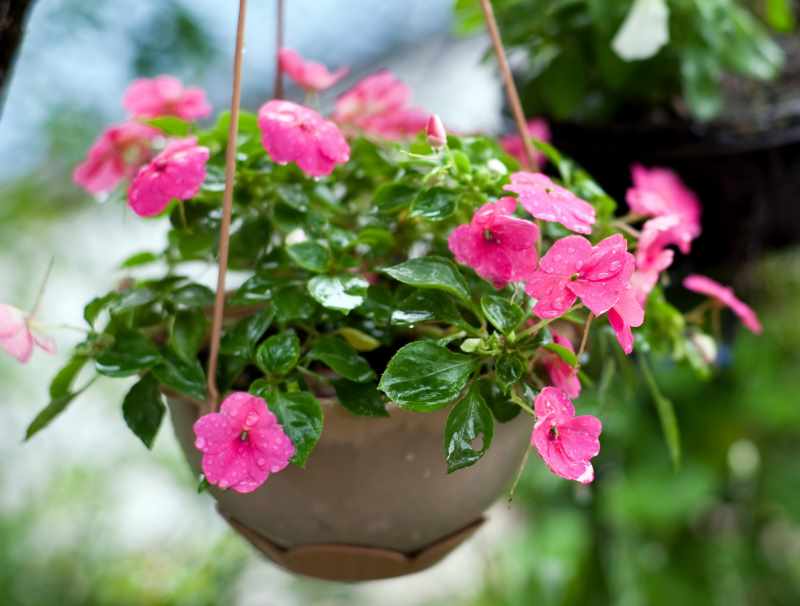

- Third.
This group includes balsams from New Guinea. New Guinea hybrids were obtained from crossing of balsam Hawker, linear-leaved, Schleiger. These plants can be found in the forests of New Guinea. New Guinea hybrids have fleshy leaves, a strong stem, large flowers, a more compact appearance. They are mainly used in indoor floriculture.
To size
Balsams can have different stem heights. It is customary to plant low-growing hybrids in indoor pots, and with the help of tall plants they usually decorate city flower beds and garden plots.
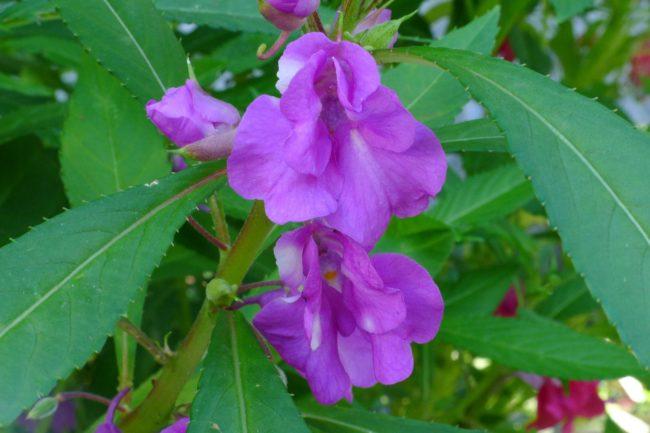

Dwarf
This group includes balsams up to 26 centimeters high. Small dwarf bushes of perennial plants are grown in indoor pots. They differ in color and flower shape. These include the various varieties of Balzamin Waller. Low-growing annuals are often planted in garden plots and city flower beds.
Medium-sized
Medium-sized plants include plants reaching 26 to 41 centimeters in height. These are compact branched bushes with green leaves and flowers of various colors and shapes. This group includes garden balsam, New Guinea hybrids.


Tall
Impatiens, whose height is 75 centimeters and above, belong to the tall group. Most often, these plants are planted as a hedge or border flower. The plant has a pyramidal or spherical shape. The stems are juicy, fleshy, the leaves are lanceolate, growing in the next order. The plant is abundantly decorated with large flowers of various shades of red.
By form
The main advantage of balsams is flowers. There can be up to 50 of them on one plant. According to their doubleness, the flowers are divided into camellia, pink and carnation.
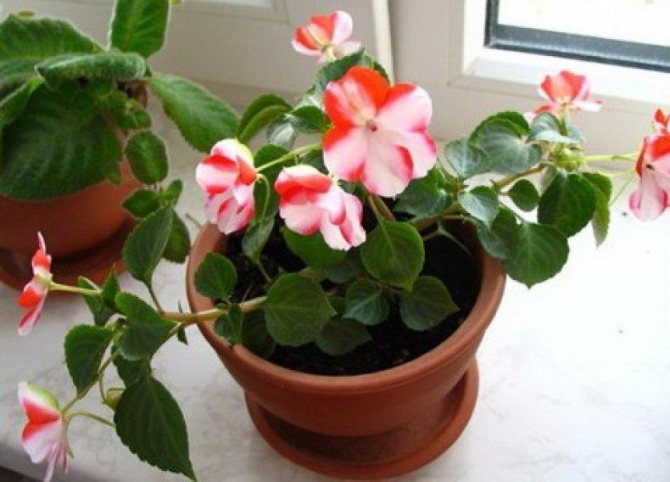

Camelliaceae
Large double flowers look like a camellia. There are pale pink, reddish, white, lilac shades.
Carnation
The flowers are reminiscent of the Dutch double carnation. The petals have fringed or scalloped edges. They can be pale pink, reddish, lilac or variegated.
Rosy
Densely double flowers resemble tiny roses. The petals are wrapped in a spiral. Flowers can be monochromatic or bicolor.
Home care
Especially lush bloom begins with the onset of summer. Despite the fact that the light is an unpretentious plant, some rules for its cultivation and care must be followed. Only in this case, he will give you the joy of his flowering.
Temperature
- For this indoor flower the ideal temperature is 18 degrees.
- In winter, it is necessary to maintain the optimum temperature. It is unacceptable for it to fall below 13 degrees.
- On hot summer days, it is better not to allow the temperature to rise above 22 degrees. In this case, the leaves of the plant will begin to dry and curl, and in the future this will lead to their falling off.
Lighting
Balsam prefers to grow in a bright place. However, very bright sunlight does not suit him, so it is not recommended to put the flowerpot on the south side.
Diffused light works best for the plant. In a shaded place flower Vanka wet will not bloom.
Watering
- On hot summer days, the light should be watered at least 3 times a week.
- In winter, the air temperature drops and the plant does not need frequent watering. At this time, it is enough to water once a week.In this case, it is necessary to ensure that the soil in the pot is completely dry.
Important! Constantly moist soil can lead to the development of illness or to the withering away of the plant.
The soil
For Vanka wet, loose and well-fertilized soil is needed. The best ingredients for such a mixture are:
- greenhouse land,
- deciduous,
- some coarse sand.
Top dressing
From March to September, when the plant is in the stage of active growth, it is recommended to feed it 2-3 times a month.
To do this, use special fertilizers intended for indoor plants. The method of application can be found in the instructions that come with the drug.
Well suited for fertilization:
- "Fertika-lux";
- "Uniflor-bud";
- "Agriculture for flowering";
- "Merry Flower Girl" for geraniums and balcony flowers;
- "Merry Flower Girl" for violets and begonias (flowering).
Advice! Balsams take well any kind of dressing (foliar and root), especially for young cuttings.
For foliar top dressing, it is necessary to dilute the fertilizer according to the instructions in soft water, which is several degrees above room temperature, and spray the agent over the entire foliage.
In August, the amount of dressings is gradually reduced. In early September, they stop altogether. In winter, fertilize balsam is not worth it.
Advice! For lush and bright flowering, fertilizers with a high content of phosphorus and potassium are used, but in no case nitrogen fertilizing.
Experience has shown that for balsam it is better to prepare a solution with a much lower concentration suggested by the manufacturer. In addition, it is better to alternate organic and mineral fertilizers.
Watch the video! Vanka wet - 5 minutes about leaving
Air humidity
The plant does not tolerate dry air, especially at high temperatures above 22 degrees. In this case, the flower pot must be placed in a bowl with pebbles and water must be poured into it. It is impossible to spray balsam, as a fungus may appear on it, which manifests itself as dark spots.
Transplants
The young plant is transplanted every year into a fresh substrate. It develops very quickly and is significantly extended in height. Therefore, flower growers often begin to grow new balsam in early spring by cuttings.
Important! Balsam blooms better in a slightly cramped pot; in a container that is too spacious, it will not differ lush flowering.
Leaf care
The dusty leaves of the fire are cleaned with a soft brush. In the summer, you can rinse it under the shower, after the procedure, you need to immediately shake off the drops of water. In order not to damage the leaves, it is not recommended to use polish for cleaning. Thanks to proper care of the plant, it will bloom almost all year round.
Possible growing difficulties
Unsuitable soil, microclimate, errors in keeping conditions are immediately reflected in the appearance of balsam. You can get acquainted with the errors of care and their consequences in the table.
Table - Possible difficulties in growing balsam
| External manifestation | Main reasons | Helping the plant |
| Vanka's wet leaves turn yellow | - Dry air; - waterlogging of the soil; - decay of roots; - excess fertilizer | - Check the root system for rot; - adjust the care regimen |
| Leaves droop | - Heat; - lack of moisture | - In the heat, balsam is sprayed; - watered regularly, avoiding stagnation of moisture |
| Vanka's wet buds fall | - Dry air; - excess fertilizer; - cold; - drying out of the soil; - invasion of pests | - During flowering, the balsam is kept in moderate heat; - watered regularly; - dilute the fertilizer according to the instructions |
| Variegated forms lose their characteristic color | - Lack of light; - excess fertilizer | - Move the balsam to a bright place or install additional lighting |
| Leaves fall, flowering stops | - Lack of light combined with low temperature; | - Until the end of flowering, maintain a stable temperature of at least 20 ° C |
| The leaves are shrinking, the stems are stretched | - Cramped pot; - lack of nutrients; - poor lighting; - heat | - Balsam is cut off, transplanted into a more spacious pot; - adjust the conditions of detention |
| Leaves curl and fall | - Cool content combined with waterlogging of the soil | - Reduce watering; - increase the temperature of the content |
If the balsam suddenly turned yellow, wilted and began to shed its leaves, this is a sure sign of stress. Its condition is negatively affected by a draft, sudden temperature changes, and a change in the intensity of illumination.
Possible diseases
- The stems of the everflower become long and bare, and the leaves lose their original appearance, it is necessary to look for the reason for this situation. First, you need to choose a place with good lighting and an air temperature no higher than 23 ° C. If the root system of the plant has grown too much, then it should be transplanted into a more spacious pot. Also pay attention to the nutrition of the flower. If the above reasons are eliminated, and the plant continues to hurt, then it just needs to be updated. To do this, cut off several strong shoots and root them in one bowl.
- The main trunk darkens and all the stems become soft. The leaves begin to curl and rot. Since Vanka wet belongs to heat-loving plants, the reason may be a lack of heat, as well as excessive dampness. In this case, you should find a warm place for the flowerpot. If it has poor drainage, then it is better to transplant into a new pot.
- The leaves turn yellow, curl and crumble. The cause of the disease can be high temperature and dry air. This can happen not only during a hot period, but also in winter, when the plant is near a heating device. In this case, find another place for the balsam and sometimes spray it.
- Roly wet does not release color or has few colors. Perhaps there is not enough light for him. The second reason may be the lack or oversaturation of the earth with mineral elements. To remedy the situation, the flower is transferred to a brighter place. If top dressing is necessary, then the necessary minerals are introduced. Sometimes it is better to transplant the plant.
- Fungus development. This problem most often occurs in winter, if the room is too cold. Also, the fungus can appear due to the constantly damp soil in the pot. The flower must be transplanted into a new container with good drainage. When transplanting, the roots must be thoroughly cleaned of the earth.
Watch the video! Vanka wet - flower treatment
Common diseases of balsam and their treatment
In home floriculture, about 10 types of balsam are popular. They all love intense lighting, high humidity, well-moistened soil, and high-quality care. If you do not provide them with all of the above, then flowers can infect many diseases. The fact that the causative agent of some ailment has entered the plant's body, it will tell by changes in its appearance. If they are detected, it is necessary to establish what kind of disease has developed on the flower, eliminate the cause of its appearance and promptly treat it.
Did you know? The people call the balsam Touchy due to the fact that even with a light touch to the seed pods, seeds shoot out of them. And from the Latin language the name of the flower is translated as "sensitive".
Root rot
This disease develops with excessive watering. It can be detected during transplantation, and it can be suspected in case of yellowing and falling foliage, observing a sluggish state. If the disease is detected in the early stages, then the plant can be saved - it needs to be urgently transplanted into a new container and soil. After removing the flower from the ground, it is important to examine the root system well and remove the roots damaged by the disease.Places of cuts should be powdered with activated or charcoal. For the purpose of prevention, healthy roots should be treated with any systemic fungicide.
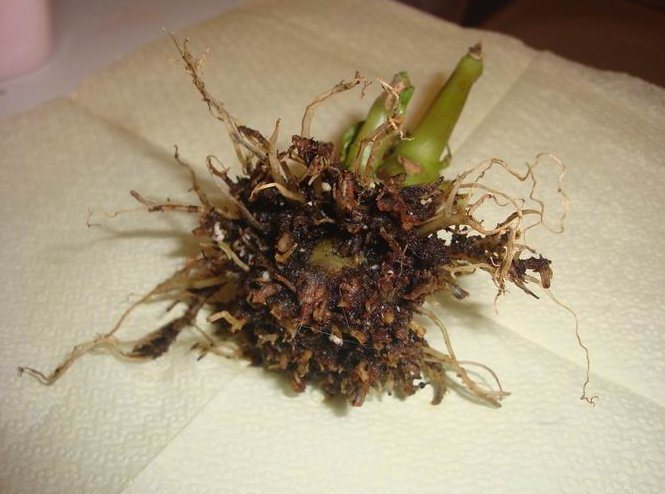

After transplanting, it is important to establish the correct regime and intensity of irrigation - they should be abundant, but without bays. If, after removing the bush from the ground, it turns out that most of the root system is damaged by rot, then it is inappropriate to save it. However, you can cut sturdy cuttings and grow young plants from them. The mother flower should be disposed of with the soil and pot.
Gray rot
Symptoms of infection with this ailment are brown spots on the leaves, white bloom on the stem, wilting. The most common cause of the development of the disease is the wrong watering regime. For treatment, treatment with fungicides is used, for example, "Fitosporin-M" or another with a similar effect. To prevent disease, you need to properly water the flower. The water should be kept warm.
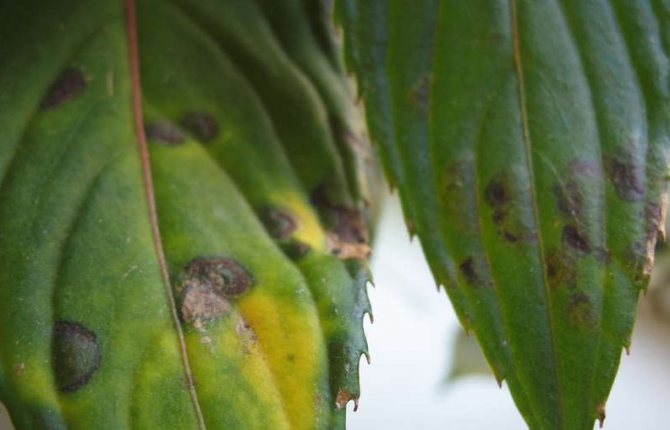

The next moistening is carried out after the top soil layer has dried. If bottom watering is used, then it is important to drain off the water that remains in the pan after 20-30 minutes. Planting the plant should be carried out only in a pot with holes to remove excess moisture, be sure to lay a drainage layer of expanded clay, broken brick or other material on its bottom.
Important! When treating plants with chemicals at home, personal safety measures should be observed: protect your hands with gloves, eyes with glasses, nose and mouth with a mask. It is strictly forbidden to eat, drink, smoke.
Powdery mildew
When growing in a room where it is constantly hot and dry, as well as with excessive moisture, there is a high risk of developing powdery mildew. A characteristic symptom of this disease is a white powdery coating on the leaves. It looks like the foliage is sprinkled with flour. Initially, it appears on the lower leaves, which soon turn black and fall off.
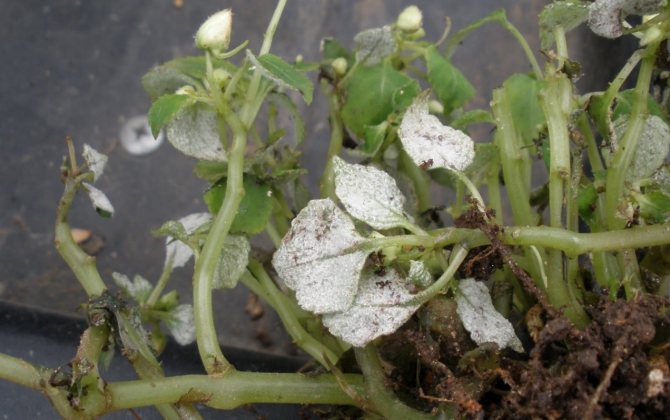

When the first signs of the disease are found, the affected leaves should be immediately removed and the flower should be sprayed with a fungicide, for example, Skor, Fundazol, Topaz, or copper sulfate. After that, it is advisable to transplant into a new soil and fertilize with potassium and phosphorus-containing fertilizer.
Bacteriosis
Growing in cold temperatures and with constant waterlogging can provoke the development of bacteriosis. A characteristic sign of the disease is black spots on the foliage. Unfortunately, this dangerous ailment cannot be treated. It is important to find it in time and destroy the plant before the disease spreads to other house flowers.


Bronze
If a plant becomes infected with bronze, its leaves, stems wilt and deform, small holes of different sizes, wrinkles are visible on the foliage. This disease, caused by a virus, cannot be cured - therefore, the plant will have to be destroyed.
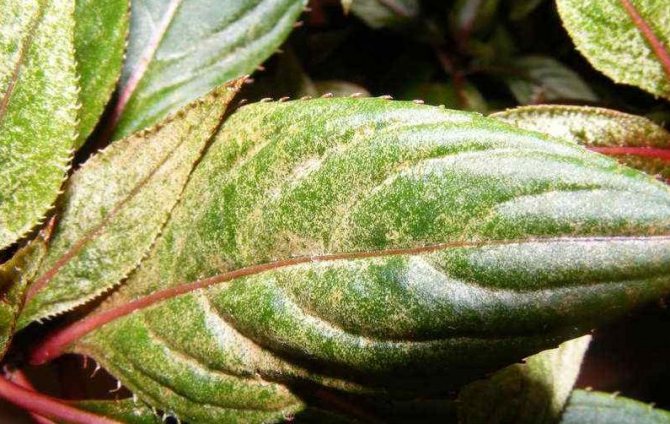

Mosaic
The causative agent of this disease is a dangerous virus that is transmitted by parasites. Symptoms of balsam mosaic damage:
- deformation of the sheets;
- the formation of yellow spots on them;
- wilting of the stem;
- stopping growth.
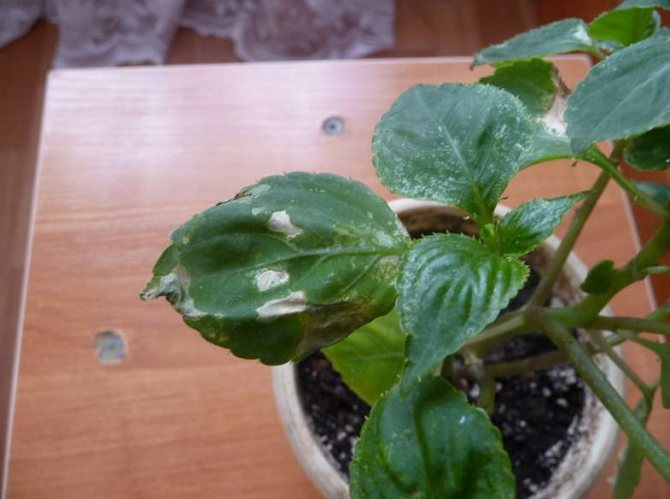

Like all viral diseases, mosaics cannot be cured, but in rare cases, indoor crops can be saved. The flower must be isolated from other plants, cut off the affected leaves, treated from harmful insects, transplanted into a new soil and pot, and provided with quality care.
Did you know? In room culture, balsam has been used since the 16th century. Medieval ladies decorated their rooms with it.
Dangerous pests
If harmful insects are bred on the plant, you must immediately begin to fight them.
Spider mite
It spreads to the plant in hot and dry air. The tick settles in internodes, spreads a web on the stems. The foliage of the flower loses color and sags. To get rid of the spider mite, you need to prepare a strong soapy solution in a large container.Laundry soap or other detergent can be used.
Redeem the diseased plant in this solution. The ground part is dipped in foam for five minutes, and then washed with clean water. repeat the procedure after 7 days. To fight the tick, you can use special drugs, for example, Nissoran.
This pest attacks the plant at the beginning of flowering. It can be found on the back of the leaves, which eventually turn silver in color, and the top of the leaves begins to turn yellow. The problem areas of the plant must be removed.
Home flower must be treated with an insecticide or infusion prepared by yourself. For this:
- take 10 g of chopped onions;
- 6 g onion husks;
- fill in with 1 liter of water;
- we insist for 6 hours.
The whole flower is sprayed with the finished infusion.
The second medicinal decoction contains:
- 100 g of chopped hot pepper;
- 1 liter of water;
- the mixture must be boiled for about an hour;
- then let stand for two days, then strain the broth;
- 1 glass of concentrated broth is diluted with clean water - 7 glasses.
The plant is sprayed with this solution.
Potential pests
Some harmful insects are also dangerous for balsam. Most often it is attacked by the following pests:
- Aphid. It is able to completely destroy the flower in a short time by drinking juices from it. It lives on the lower leaf plate, is a miniature green or black insect. The first signs of the presence of a parasite are yellowing and curling of the foliage. At first, the plant can be helped by wiping it with soapy water. If such manipulations do not help, it is worthwhile to carry out chemical treatments. Aphids are fought with the help of Fitoverma, Actellik, Intavir or other insecticides.
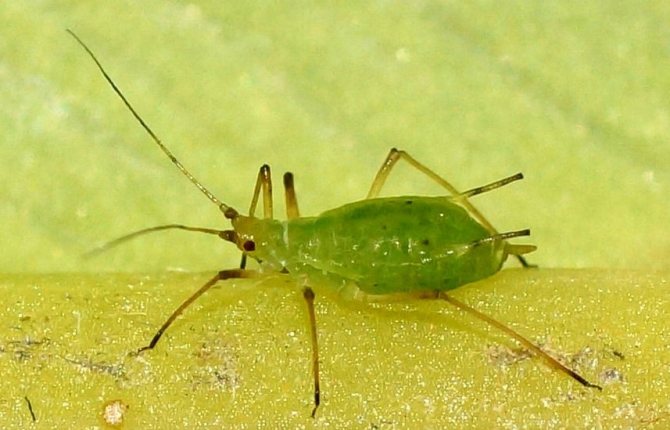

- Spider mite. In the course of his life, he enmeshes the flower with cobwebs, feeds on the juices of the plant. Its appearance leads to the fact that the balsam leaves turn yellow, dry up and fall off, the flower withers and soon dies. To combat the pest, use "Aktellik", "Fitoverm", "Sunmayt", "Aktofit", "Fufanon".
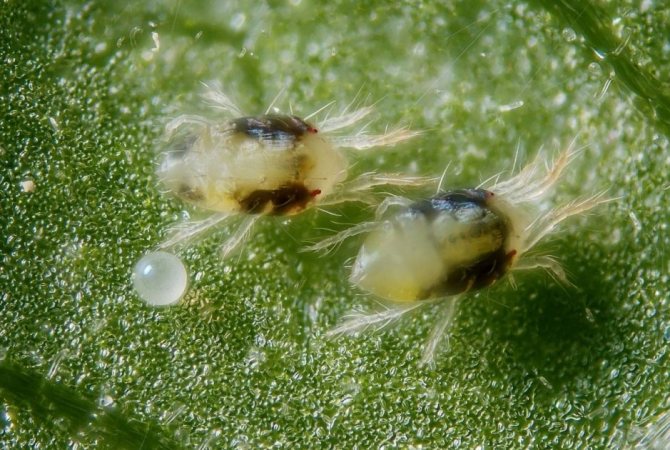

- Whitefly. It is a small butterfly with white wings. If you often see her fluttering near a flower, then she probably laid eggs on it, from which larvae will hatch, eating leaves. They fight against a butterfly and larvae by spraying with Aktellik, Iskra, Aktara, Fitoverm. Folk remedies are also used - processing with tobacco, dandelion, garlic infusions, dusting with wood ash, washing with soapy water.
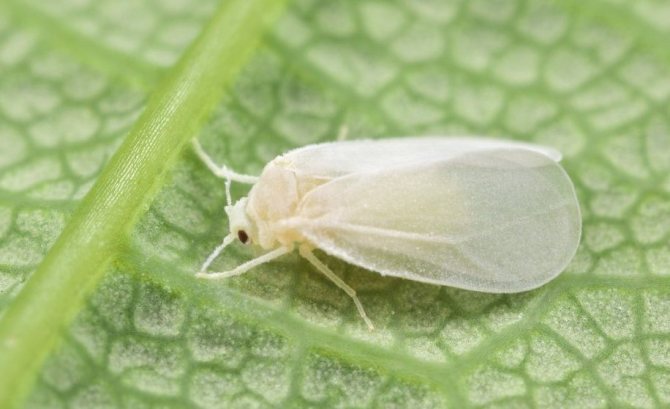

Reproduction of balsam
Plants begin to reproduce in the spring and summer. There are two types of breeding:
Ready-made seeds can be purchased at the store or collected after pollination of the flower. Seeds are planted in a separate container and after 2 weeks you can get seedlings.
Cuttings placed in water will root also within 14 days. It is recommended to put 3 pieces of charcoal in the water. For reproduction of balsam, lateral shoots are cut off about 8 cm in length. Cuttings with ready-made roots are planted in small pots.
Young animals need warmth and high humidity. Therefore, the dishes with them are covered with foil. The plant needs to maintain a constant temperature. But in winter, when the flower is resting, it is recommended to lower the temperature to 14-16 degrees.
Popular species and varieties
Most of the varieties are obtained on the basis of garden balsam, Waller or Hawker, which became the progenitor of the famous New Guinea hybrids. Plants differ in stem shape, height, structure and color of flowers.
Hawker's Impatiens hawkeri
The plant that gave birth to New Guinea hybrids. Leaves - oblong, pointed at the end, shiny. The flowers are large, simple, with a spur, of various shades, with a white core. The height of the balsam is 25-60 centimeters. Stems are erect, long, fleshy.
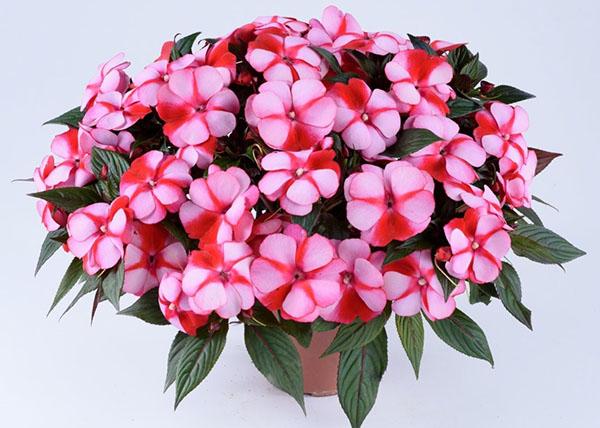

Large-flowered Impatiens hookeriana or Impatiens grandis
The plant is native to Sri Lanka. It has long, fleshy stems. Leaves - shiny, as if covered with wax, green. Flowers - large, like an orchid, white, pinkish, scarlet.
See also
When to prune irises after flowering for the winter, terms and rulesRead
Creeping Impatiens repine
The plant is used in hanging pots, it has creeping, upward, very fragile reddish shoots that break off easily during strong winds. Leaves are small, shiny, bronze-green. The flowers are bright, yellow, large, with a spur.
Impatiens walleriana or Impatiens Waller
A perennial plant often grown as a garden annual. Waller's balsam is a low, strongly branched spherical bush. Flowers can be simple or double, of various colors, located at the top of lush green foliage.
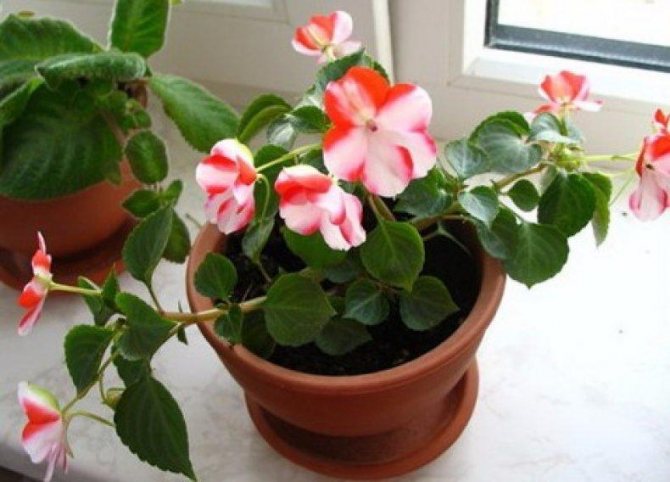

Forest
An annual, herbaceous, poisonous plant. It grows one meter in height. Stem - erect, covered with leaves, can branch. The flowers are like a shoe. They can be pale pink or lilac.
The most common types of balsam
In nature, there are about five hundred varieties of balsam or Vanka-wet. On the windowsills of Russians, you can find many of their species, not excluding hybrid varieties such as:
- Balsam Waller. This is a bushy plant reaching a height of about 50 cm. The stems of the flower are erect, and the leaves can change their color from pale green to dark brown with a reddish tint;
- Balsam "Tempo FT". It is a rather large fleshy plant that pleases the eye of flower growers with its early flowering;
- Balsam "Stardust FT". This variety of Vanka-wet is endowed by nature with petals with a slightly silvery bloom and a brightly colored border around the edge.
We suggest that you familiarize yourself with: Are there fleas from indoor plants
Watering subtleties
Vanka loves moisture very much, which means that he needs frequent but moderate watering. So, in the summer, it is recommended to water a little, but every day or more abundantly, but every other day. In winter, the plant should be watered no more than 2-4 times a week if the room is hot.
In this case, care should be taken that water does not stagnate in the sinuses of the soil. If stagnation has formed, then you can either add soil, remove the flower in a warm place so that the water evaporates, use cotton wool, just drain the excess water.
Flower Wet Roly: cultivation features
In total, botanists identify more than 600 species, including indoor balsam.
There are two large species of this plant: annuals and perennials.
But, regardless of the type, there are several general rules for caring for Vanka:
- Vanka is a wet flower - a name that arose not by chance, but due to its moisture-loving nature. The flower needs regular watering, otherwise it stops blooming, and the leaves lose their freshness, brightness and healthy appearance. The lack of moisture is expressed in the fact that at first the bush becomes drooping, you can see how the stems literally lie down. You can also see how, after abundant watering, the plant comes to life right before our eyes, the leaves are filled with juice, the ovaries of the inflorescences are formed, and the stems acquire the same resistance.
- Watering in winter can be somewhat reduced, but in the summer and spring months, especially during the heat, it is better to pour the bush than to underfill with water. It starts to wither quickly. In rooms where it is too hot, watering should be done every other day.
- Abundant flowering is provided not only by top dressing, but also by the small size of the pot. Experienced gardeners often plant indoor balsam in small plastic pots and seedlings, and then place several of these pots in a rectangular flower tray. To make such a composition decorative, tow or a stone-sand mixture is used.The latter provides drainage, moisture retention and aeration. For decorative purposes, the composition is formed from balsam with inflorescences of different colors.
- Flowering is also directly related to the quality of pruning and lighting.
- Balsam is photophilous, in the shade the plant continues to grow, but with less intensity, and the flowering is significantly reduced and is short-lived.
The general principle of plant care is to feed them regularly. Vanka is not particularly picky about her, but the use of mixtures for indoor flowers, such as "Ideal" provides an improvement in the appearance of the color, and also improves flowering. Let's consider in more detail the subtleties of caring for balsam.
The history of the emergence of a flower
The birthplace of Vanka-wet are the Eurasian countries. Various informative sources mention Africa, Asia, as well as America. By the end of the 6th century, the balsam is in Great Britain. It was presented as a gift to Queen Elizabeth I, and indescribably delighted her with its royal beauty.
In the Russian state, balsam appears only in the middle of the 19th century, and it was the Russians who christened him Vanka-wet, for his excessive love for moisture. Thanks to its abundant and bright flowering, balsam acquires another common noun - a light. The residents liked it for its cheerful color and unpretentious care.
For the first time, balsam was seen in the tropical, subtropical territories of Asia and Africa. In 1596, this plant appeared in Europe, more precisely in Great Britain. There, the balsam was presented as a gift to Queen Elizabeth I. She was incredibly fascinated by its beauty.
How to save a frozen plant?
Drafts and temperature drops are detrimental to delicate balsams. If they became the reason that the plant began to die, you can try to correct the situation. To do this, all the frostbitten parts of the flower are removed and cut to a living and healthy tissue, after which watering is temporarily reduced. While the injured balsam is sick, he is provided with extremely gentle conditions. In some cases, growers save the plant in a radical way, dividing it into cuttings.
Frozen leaves on cuttings, as in the previous case, are removed and cut to intact tissue.
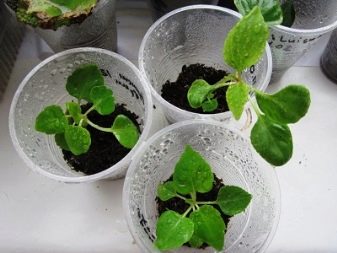

Where to put and who to give Vanka Wet
Undoubtedly, Balzamin will be a wonderful gift for a person or for a family that you wish happiness to. Your present can be accompanied by a story about the properties of the plant, about the need to take care of it.
A good omen is to present Balsamin to the newlyweds. For a newly-made family, an indoor flower will help to survive the period; grinding to each other, sometimes discharging the heat of passions.
Where to put it?
If Vanka is placed near the bed where the man is sleeping, he will fuel his masculine strength.
In the living room or in the kitchen, where the family often gathers in its entirety, the plant will give people uplifting, unite children and parents, spouses.
Located in the nursery, Vanka Wet will help the child develop creatively, do well in school, and not be lazy. Especially if the flowers of Balzamin are of a rich bright color.
Undoubtedly, Balzamin will be a wonderful gift for a person or for a family that you wish happiness to. Your present can be accompanied by a story about the properties of the plant, about the need to take care of it.
A good omen is to present Balsamin to the newlyweds. For a newly-made family, an indoor flower will help to survive the period; grinding to each other, sometimes discharging the heat of passions.
Where to put it?
If Vanka is placed near the bed where the man is sleeping, he will fuel his masculine strength.
In the living room or in the kitchen, where the family often gathers in its entirety, the plant will give people uplifting, unite children and parents, spouses.
Located in the nursery, Vanka Wet will help the child develop creatively, do well in school, and not be lazy.Especially if the flowers of Balzamin are of a rich bright color.
A good omen is to present Balsamin to the newlyweds. For a newly made family, an indoor flower will help to survive the period of "grinding" to each other, sometimes relieving the heat of passions.
Where to put it?
Vanka wet is one of his names. In floriculture В
Please watch: "Anthurium care and watering" ps: //www.youtube
READ ABOUT ROOM FLOWERS ON OUR WEBSITE p: //nefertiti.cli
So, in addition to its beautiful appearance, Balzamin is also an assistant for the whole family.
Donation rules
The light can be given to a married couple, a single man, an active business lady and a young lady "in search".
If a mother living in a happy marriage gives an adult daughter a rooted stalk of Eternal Blossom, the girl will soon meet her betrothed.
A man who has a reputation as a womanizer should not give Vanka. Otherwise, the light energy of the flower will conflict with the base desires of its owner. The bush may fade.
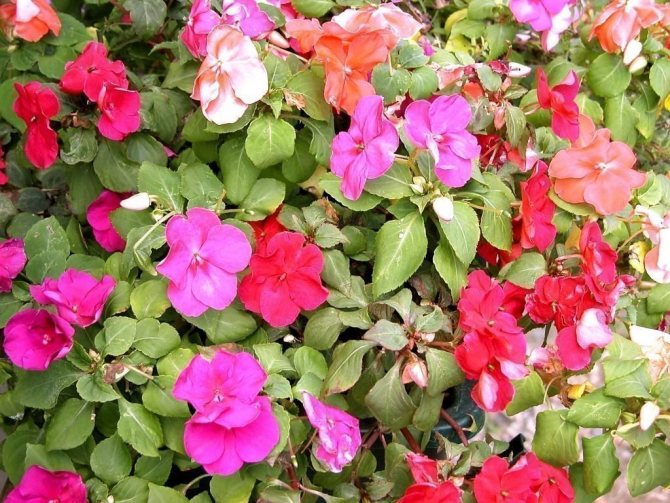

According to superstition, you cannot accept Impatient as a gift from a widow or a sick woman. It is undesirable to take cuttings of a flower from an apartment where a theft has recently occurred. The family in which the premature baby was born does not give flowers to its relatives for a year.
Whether the energy potential of the Eternal Blossom will be able to unfold in your home depends not only on the personality of the donor. In order for your favorite varieties of balsams to please you with long flowering, refrain from scandals and properly care for the bushes.
Seedling growing
Balsam is a thermophilic plant with a long growing season. When the temperature drops to 5 degrees Celsius, it may die. To get a flowering bush in June, in March you need to sow seeds for seedlings.
Disinfection
Before sowing seeds, you need to prepare the soil. You can buy a ready-made soil mixture based on peat. You can prepare the substrate yourself. To do this, you need to take in equal proportions garden, sod or leafy soil, peat, sand. It is advisable to disinfect the substrate with boiling water, a solution of potassium permanganate or Fitosporin.
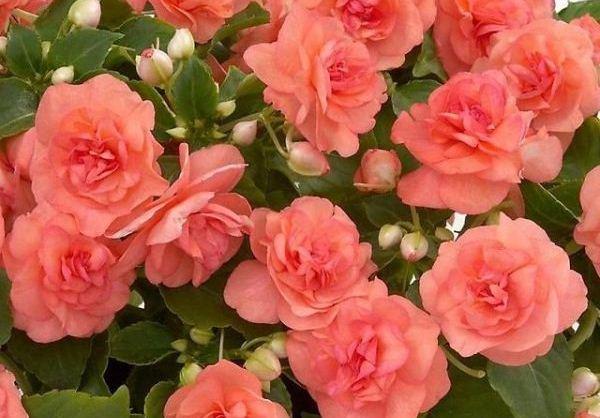

Landing scheme
Balsam seeds are sown in boxes filled with substrate, at a distance of 1 centimeter from each other. Previously, the earth is loosened and moistened. From above, the seeds are lightly sprinkled with sand and sprinkled with water. When the seedlings germinate, they will need to be dived and planted in separate containers.
Film or glass
Seeds sown in the ground are irrigated with water and covered with transparent glass or foil. Every day the glass is raised, the ground is lightly irrigated with water. When shoots appear, the film is removed.
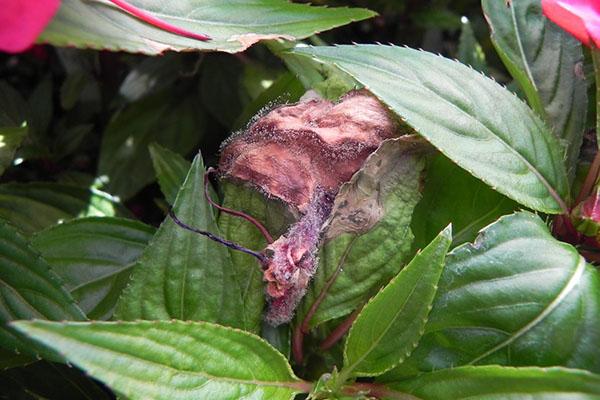

Landing and aftercare
At the end of May, the grown seedlings are transferred to the street. Plants are carefully planted together with an earthen clod in the dug holes. In summer, Touchy must be regularly watered, weeds removed from the flower bed and fed with complex fertilizers once a month.
Planting and care in the open field
Balsam can be planted in front of the windows of your house or in a city flower bed. Seeds for seedlings are preliminarily sown in March. The grown seedlings are transferred to the street at the end of May or at the very beginning of June. Before transplanting, the seedlings are accustomed to outdoor conditions.
The optimum temperature for planting outdoors is 18-20 degrees Celsius.
Landing features
Roly Wet in the garden is grown as an annual plant. Loves non-acidic, light, well-drained soil. It is better to plant balsam in a bright and well protected place from the wind. Before planting, the soil must be fertilized with humus, add a little sand or peat, loosen and moisten well. Seedlings are planted in shallow pits, on the bottom of which a little sand is poured. The distance to the neighboring plant should be equal to 30 centimeters.
Watering and feeding
Balsam will bloom profusely if watered regularly. It is undesirable to fill the soil with water.In swampy ground, Impatiens will begin to rot. Adult plants are watered and irrigated with water every other day. However, in rainy weather, watering is stopped.


During watering, young plants are additionally fed with nitrogen substances. During the flowering period, the land is fertilized with potassium and phosphorus. You can use complex commercial fertilizers for flowering plants. The touchy is fed once a month.
Causes leading to diseases of balsam
Home flower balsam is a moisture-loving plant. The stems and leaves are half water, so the wet Roly needs high air humidity and moistened soil. Water is not only a source of life for plants and people, but also for disease-causing bacteria and pests.
It is recommended to water the flowerpot with clean and warm water. The pot in which the flower grows must have a drainage hole and a drainage layer. The earthen mixture should be loose, moisture and air permeable. To disinfect the soil, it is recommended to add charcoal to it. Such a substance will prevent the appearance of putrefactive bacteria and fungi.
If you take proper care of the plant, it will grow strong, and diseases and pests can be easily destroyed with special means.
Balsam disease
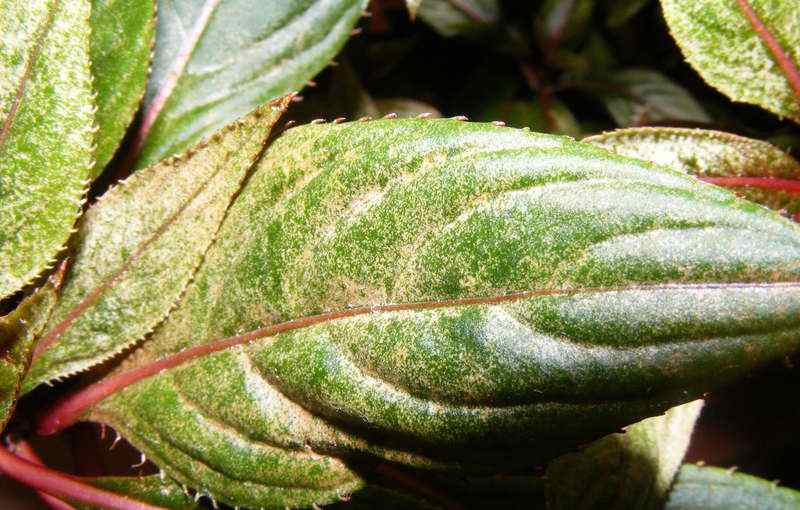

If the leaves of the touch-me-not began to fall off, and the buds disappear without opening, the reasons for this condition may be the following situations:
- perhaps the flower is simply undergoing adaptation in a new place after purchase. The adaptation period can last for a month. It is important to properly care for balsam: water, feed, spray on time. Proper care will help the plant acquire beautiful stems and new leaves;
- leaves may fall off due to overdried soil. The earthy mixture cracks and falls off the edges of the pot. Dry soil leads to yellowing, drying, curling of leaves. It is recommended to water the flower every seven days;
- balsam leaves fall off when the soil is too moist. This is evidenced by the moist soil layer on the second day after watering. If the plant does not have time to dry the soil in a week, it should be transplanted into a container of a smaller diameter;
- if the leaves of the plant were covered with a white bloom, and they began to gradually wither and fall off, it means that the balsam suffered from the attack of a spider mite. All measures must be taken to remove it;
- if the balsam leaves wither on only one side, the irrigation procedure should be normalized, since the soil is too moist.
The leaves of Vanka wet can wither and become covered with round brown spots due to too wet soil. It is recommended to water the flower sparingly by adding Fitosporin-M to the water.
The appearance of gray rot
Brown spots appear on the leaves and stems of balsam. This fungal disease is called gray rot. If you do not help the plant in time, it will disappear.
Disease-causing bacteria enter the flower along with water or contaminated soil. The disease can occur due to hypothermia or freezing of the roots of the flower. Drafts, cold water, low air temperature in the room can also lead to the appearance and reproduction of rot.
Gray rot should be removed immediately at the first symptoms of its manifestation. Cut off the affected parts of the flower, and transplant the healthy parts into a new pot. You can spray the plant with garlic infusion or foundation.
Development of bacteriosis
Watery spots can be seen on the balsam, which indicate the development of bacteriosis. With such a disease, the spots quickly increase, become brown in color, and soon lead to the death of the flower.
Balsam can be infected with bacteriosis through contaminated soil, dirty tools or dirty hands. The disease often occurs due to excess moisture, as well as fertilizers in the soil, polluted air.
Prevention
In order to avoid the occurrence of diseases in a plant, it is necessary to carefully care for it.
Water the flower in time. Do not overmoisten the soil, observe the temperature regime. The optimum temperature is 12-25 degrees.
To prevent the occurrence of various diseases, feed every 15-20 days from May to September, and periodically wipe the leaves with soapy water, and then rinse them with a shower.
Balsam: signs and superstitions
Wise women are the keepers of the hearth, take care of the household, the well-being and prosperity of the house, and a cozy atmosphere.
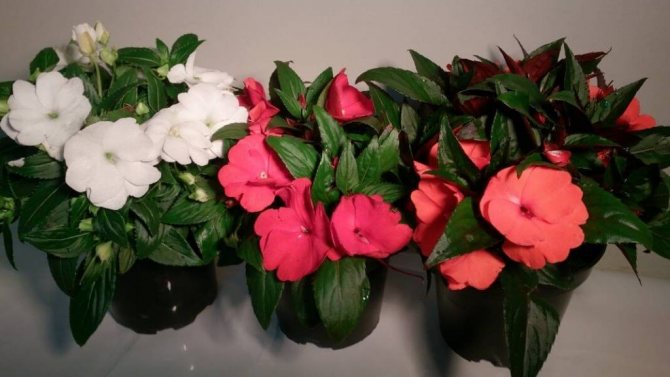

So that PSC ‡ RyoSЃS‚RёSС РєРІР ° С “РёСС РѕС‚ РїР ”РѕС… РѕР№ энергетики uninvited guests or past residents - it is enough to put a few indoor plants for them to" wash " housing.
- Married couples swear less at the sight of a flower.
Firstly, there is a belief that Vanka is a peace-loving plant, and one rude word can lead him to death, that's why he was nicknamed “touchy”. Family men, whose house is full of passions and clarifications, become kinder to each other, argue and swear less.
Wet flower Vanka - signs for men
Balsam is a unique plant that is used both in everyday life and in folk medicine. In addition to magical properties and improving the aura in the house, it has properties such as a positive effect on the male gender. The women noted that РїРѕСЏРІР »РµРЅРёРµ С † веткР° РґРѕРјР ° made its own adjustments:
- Men have become more self-confident;
- Good luck and success in business appeared;
- Husbands are less likely to get sick;
- The stronger sex has become less irritable, more positive and patient.
It is very important to maintain men's health, since husbands have long been considered the breadwinners and breadwinners of the whole family. Therefore, it is important to maintain order and comfort at home, strengthening the atmosphere with different symbolic colors. But there is also a fly in the ointment in this whole story.
Therefore, wives often refer to this plant when an alcoholic appears in their house instead of a healthy and strong husband.
Care features
Vanka Wet is a non-capricious plant. It does not require any special care, only a minimum of attention. The main thing is to ensure Impatient regular watering and timely fertilization.
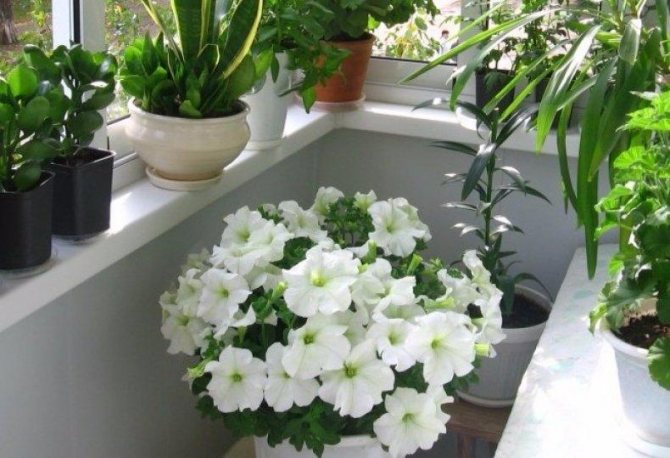

Watering
You need to water the Touchy one regularly, make sure that the earth does not dry out. Balsam instantly reacts to a lack of moisture - its leaves curl, flowers droop. With insufficient watering, the plant can shed flowers and buds.
Spraying
It is advisable to irrigate balsam every other day with cold water. This procedure will save the plant from the spider mite and saturate the touchy with moisture.
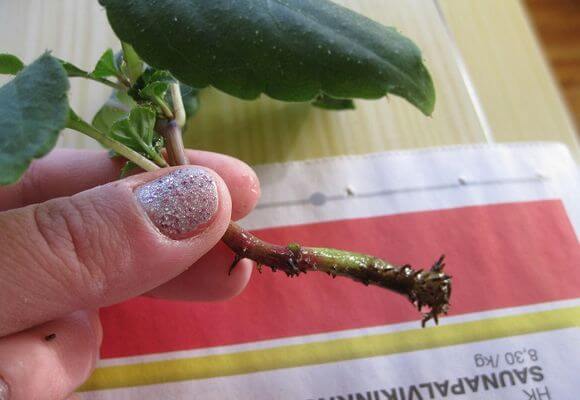

Pinching and trimming
It is necessary not only to look after balsam, but also to pinch it correctly. When the plant grows a little, it is advisable to shorten its top. The balsam will no longer stretch upward, but will begin to form side shoots. The plant will take the form of a spherical, compact bush. True, for this you need to constantly cut off the stems that are too elongated.
Top dressing
For abundant flowering, Impatient needs to be fed 1-2 times a month with complex fertilizers for flowering plants.
It should be remembered that with an excess of nitrogen supplements, the plant will receive lush greenery, and flowering may not come.
Hardening
Usually Impatient, sown on seedlings, is hardened before being transplanted into the street. The room where the seedlings grow is regularly ventilated. In May, in warm weather, boxes with seedlings are taken out into the sunlight for several hours.
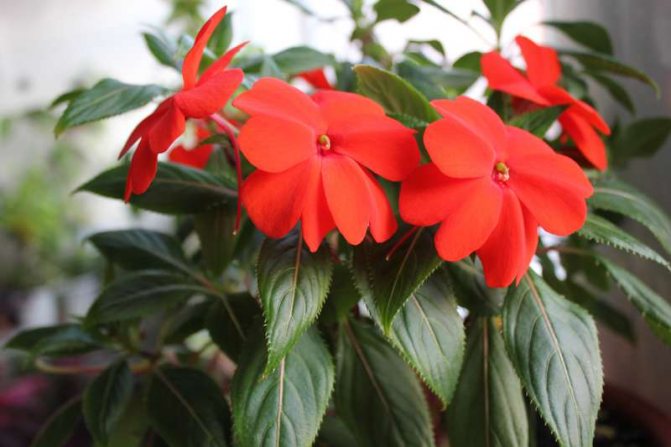

Wintering
In the fall, the yellowed and fading garden balsam is cut off, the roots are dug up and removed from the flower bed. Save the bush in winter will not work. With the onset of frost, he will quickly die. The next season, a new plant is sown.
Pruning
Balsam should be pruned in the spring or early summer so that the plant takes the form of a compact, low bush.Usually at the stem, 30-40 centimeters long, pinch the top. Balsamin begins to actively form lateral shoots.
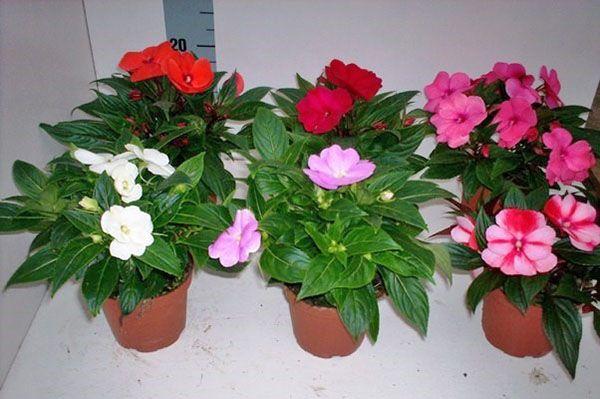

Pruning indoor balsam
Understanding when a plant needs pruning is not difficult.
- As soon as the balsam bush has released too many lateral shoots or becomes too tall:
- When the shoots reach the desired height, they must be pinched, which will contribute to the growth of lateral branches;
- If there are too many side shoots, they must be cut off;
- A bush should be formed with a height of no more than 30-35 cm, if the pot is medium-sized, if the pot is small, then 20-25 cm is enough.
Pruning will give the bush a neat look and improve the flowering process.
Why do the leaves curl?
There could be several reasons.
- Curling and deformation of the leaves often indicate that the flower lacks moisture and light. These indoor plants do not tolerate lack of watering and darkness.
- Very dry air in a room can also cause leaves to curl. In this case, spraying allows them to restore their previous appearance.
- Direct sunlight can negatively affect the condition of the leaves. To protect the plant from sunburn, it needs to be provided with soft but sufficient lighting. It is recommended to shade balsams in hot and sunny weather.
Important! Having noticed that the plant is dying, and the shape of its leaves has changed greatly, it is important to carefully examine the flower for the presence of pests or traces of diseases. Inspection of the problem plant is best done using a magnifying glass.
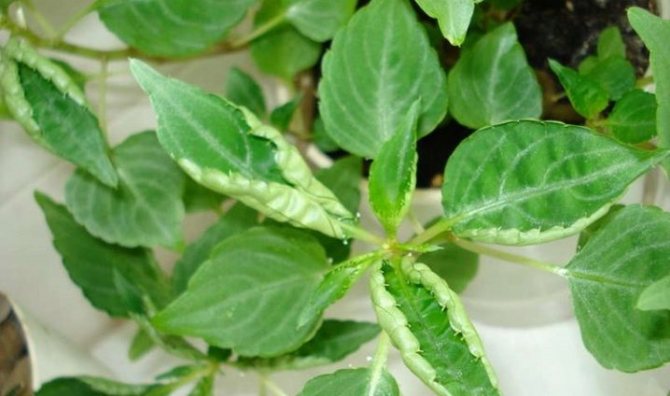

ethnoscience
- The people use the summer inflorescences of the light for decoctions and tinctures. They are used as an antiseptic for cuts and other shallow wounds.
- They drink as a laxative, to cleanse the body of toxins, toxins, use it as a diuretic, and many also use decoctions of this plant as a medicine for gallstones and kidney stones.
A bath with wet vanka petals relaxes and normalizes blood flow, which stabilizes blood pressure. Such baths are also the prevention of rheumatism.
Quote from the post of Bausov_Natalia
Balsam room or Vanka Wet. Growing up, medicinal properties and signs.
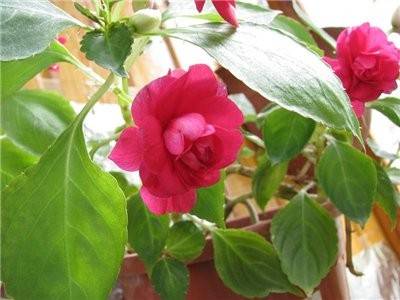

Roly-wet, balsam, light, ever-flowering, touchy
- as soon as people did not call a houseplant, which is known to science as Impatiens. Before becoming the favorite of most housewives, the flower covered a considerable distance. After all, its historical habitat is tropical and subtropical countries of Asia, America, Africa.
Balsam first appeared in the UK. At the end of the 16th century, it was presented as a gift to Queen Elizabeth I. The ruler was struck by an unusual flower, on the stems of which were frozen sugar tears.
This plant was brought to Russia at the beginning of the nineteenth century. The Russians loved him for his unpretentiousness. And for its ability to bloom, practically, all year round and decorate the house, the plant began to be called an eternal flame either ever-flowering
.
In Russia, balsam is known and loved so much that it was “noted” even in classical Russian literature - remember Balzaminov from the play by A.N. Ostrovsky "What you go for, you will find" or the lines of Dostoevsky's novel "Poor People": "I see the corner of the curtain by your window is bent and attached to a pot of balsam ...".
"Vanka wet"
This flower is popularly called - in inclement weather, with the approach of a thunderstorm, during fog, as well as with abundant watering, droplets of water stand out on the sharp tips and serrated edges of its light green leaves - the plant becomes really wet.
Name and "Light"
- in the dark foliage its flowers-lights "burn": white, pink of all shades, salmon, orange, yellow, red, purple - one-color, as well as with an "eye" or stripes, - "burn" in any weather, 6-8 months of the year (what other plant will bloom as long?).
There is one more "Russian folk" name for the flower - touchy
... After pollination of balsam flowers, fleshy green fruits are formed. But the juicy "berry" unexpectedly dries up, turning into a box. One has only to touch it lightly, as it bursts, shoots out rather large seeds and twists its shutters inward - here you are "touchy".
In England, this plant is also loved - and with love they call it "zealous Lisa", for the eternal flowering, to look for such a hard worker.
If you are a novice florist, get a balsam. You will not regret! It is no secret that most indoor plants are considered a mysterious way of influencing the life of the inhabitants of the apartment. Therefore, there are many beliefs that housewives pay attention to before letting this or that flower into their home. So, in the Russian outback, it is believed that the appearance of Vanka-wet in the dwelling will become the cause of her husband's alcoholism in the future. The reason for such reasoning-fears was the droplets of juice on the stems of the plant. This is the only "stain" on the reputation of balsam.
Most consider him a protector and benefactor of creative people. Some even manage to anticipate the development of their careers (difficulties and ups). The secret is simple: if a flower grows, blooms, then nothing threatens its owner. And as soon as the plant begins to ache and dry out, troubles and negative changes occur in a person's life.
The presence in the house of such a resident as Vanka-wet helps to gain self-confidence, open up hidden reserves, and give the necessary energy boost at a new stage of life.
As folk signs testify, the people consider Vanka-wet the flower of "male happiness". In order for masculine strength never to leave the representatives of the stronger sex of the family, it is not at all necessary to prepare any special potions, tinctures or potions. It is enough just to put the plant in the bedroom or study, for example, on the window. Therefore, it was not in vain that the newlyweds were given balsam as a wedding gift.
People say that Vanka-wet has an overly sensitive aura. Even a careless, harsh word can significantly reduce its positive impact. Therefore, the spouses who "sheltered" the balsam in the house should avoid quarrels and showdown in their home.
Care and cultivation of Balzamin:
It is easy to care for. The main thing is not to forget to drink. The soil in the pot should always be wet (remember - he's wet Vanka). With a lack of moisture, the leaves immediately dry out, wither, turn yellow and soon fall off. If you do not water the plant for 2-3 days, the tops of the stems will begin to dry out and the balsam may die. Daily watering may be necessary in summer. In winter, watering is reduced.
Content temperature:
Moderate, in winter not lower than 12˚С. For the plant to bloom in winter, the temperature must be at least 15С. He's an African - he loves warmth!
Lighting:
The plant is photophilous, but in summer it should be protected from direct sunlight by moving the plant to the shade. Blooming in winter requires several hours a day of direct sunlight.
Air humidity:
From time to time, the leaves should be sprayed, avoiding water getting on the open flowers.
Transfer:
It blooms well only if the roots fill the pot. Soil - 1 part of sod land, 1 part of leaf (peat), 1 part of humus, 1 part of sand. Drainage is required to the bottom. It is better to transplant balsam annually in the spring (in March), while it is not necessary to take a larger pot, since Vanka does not like wet dishes that are too spacious, it is enough to completely replace the soil.
Reproduction:
Stem cuttings at any time of the year or seeds in spring. You can rejuvenate the plant quite often, i.e. cut fresh, long, stronger cuttings, and, after rooting, plant instead of the old plant, over the summer they will have time to grow strongly.
If the plant has little light, it stretches out and becomes ugly. I recommend that you renew the balsam about once a year - the cuttings root easily in the water, sometimes even without stopping to bloom. You can plant several plants, both of the same color or different, in one pot - the effect will be amazing.
If you are an experienced florist, you should not snort dismissively towards balsam: have you seen the latest innovations? What colors are there! What terry! There are even variegated varieties!
What else is balsam good for?
In recent years, I like to plant it on the balcony and in the country. Blooming edges in our garden have long been the subject of discussion and envy of neighbors. When balsams are grown outdoors, they like a bright, but protected from direct sunlight place - balsam flowers are brighter and larger.
Problems with growing balsam
♦ The stems are elongated, the leaves are small and pale - when there is a lack of nutrients in the soil, or when the pot has become cramped, as well as when there is a lack of lighting. In addition, most types of balsam are characterized by rapid "overgrowth", which makes the plant elongate, the stems at the base become bare, and decorative attractiveness is lost. This is facilitated by high temperatures (above 22 ° C). Therefore, it is advisable to renew the balsam in the spring by cutting off and rooting several young cuttings in one pot.
♦ Stems rot (brown and soften), leaves curl, fall off if it is too cold and damp. This can happen if the plant is exposed in the summer in the garden, with the onset of cold rainy nights.
♦ Leaves curl, dry and fly around - if the air is too hot and dry. This should be feared in winter if the plant is near the radiator. And also in summer, on hot sunny days, then the plant must be placed on the floor in the coolest place of the apartment, and periodically sprayed.
♦ Variegated forms lose their color - when there is a lack of lighting, for example, on the northern windowsill.
♦ Weak or no flowering - the cause may be a lack of light, a lack of nutrients in the soil, or an excess of fertilizer (improper feeding, for example, with nitrogenous fertilizers).
♦ Unexpected flowering and cessation of flowering - can be caused by a sharp cold snap, severe dryness of the soil, transplanting into a too large pot or untimely transplanting (flowering or budding time).
Balsam pests:
A spider mite often infects balsam, especially in hot dry weather - in internodes, cobwebs appear on the stems, the leaves become lethargic, pale and fall off.
Control measures.
The entire surface area must be rinsed in soapy water. To do this, dilute a cool soap solution in a bucket of warm water (you can use green soap, tar, and even foam for washing dishes). Then lower the plant upside down and leave for five minutes. Rinse off the foam with warm clean water from the shower. Repeat the procedure in a week. If soap baths do not help, balsam should be sprayed with a solution of acaricide (drugs: apollo, nissoran, vermitek, actellik and others).
Also balsam, especially growing in the summer in the garden, can be harmed by aphids, whitefly and thrips. Be sure to inspect the underside of the leaves (pests usually hide there), pay attention if the leaves curl, turn yellow or acquire a gray-silver tint. The easiest way to deal with the above pests is with the help of systemic insecticides - actara or confidor, with a solution of which the soil is watered. All sick, spoiled leaves must be cut off.
Composition and medicinal properties
Note that the composition of the plant is not well understood. Therefore, its medicinal properties are also not fully known. Some research suggests that this plant contains poison.
However, despite this, balsam is actively harvested during its flowering period, because it is at this time that it contains the highest concentration of vitamin C. For this reason, this remedy is used to treat various inflammatory processes. The balsam flower contains tannins necessary to support vital processes, flavonoids and alkaloids.
Most often, phytotherapists use the ground part of the plant for medicinal purposes. Its components are a component of herbal diuretics.
Such drugs have a beneficial effect on the functioning of the kidneys and on the entire urinary system of our body, since the substances in balsam are able to break down salts and stones, and remove them along with excess fluid from the body. For this reason, touchy is used to treat cardiac and renal edema.
Also, this medicinal plant is high prized in Chinese traditional medicine
.
According to oriental healers, it perfectly helps to cope with the normalization of the menstrual cycle, treats toxic poisoning. Some research suggests that balsam can stimulate labor. However, its relation to the category of poisonous plants does not give grounds to use it to stimulate labor.
Balsam found its special medicinal niche and in medicine of Tibet
.
There, with its help, they treat diseases such as ascites and spasmophilia, diabetes mellitus. Also, Tibetan medicine actively uses the sedative properties of this natural remedy. Under the influence of the medicinal plant, the nervous system calms down, the heart rate slows down, the amplitude of the heart contractions increases.
The use of balsam in traditional medicine: recipes
1. Infusion for the treatment of kidney stones.
It is used by herbalists from the Caucasus and Asia, the Urals and Siberia for soft removal of stones from the kidneys. It is necessary to take a teaspoon of crushed fresh leaves of the plant and pour over them with 200 grams of boiling water. After half an hour of infusion, the agent is taken in a tablespoon each time after a meal. But first, this healing liquid should be tested for tolerance by the body. After all, sometimes it can induce vomiting.
2. Treatment of wounds and hemorrhoids with balsamic leaves.
Fresh leaves of this medicinal plant are used as a remedy for hemorrhoids, ulcers, wounds. To do this, the washed balsam leaves must be kneaded in the hands and applied to the skin lesions. If at the same time there is a strong burning sensation, then the leaves must be removed and the skin washed. This is the individual intolerance to balsam.
3. Infusion for the treatment of rheumatism.
External use of balsam in the form of decoctions is very effective in the treatment of rheumatism. You need to take 100 grams of fresh balsam leaves and pour over them with one liter of boiling water. After complete cooling and filtration, the balsamic infusion is poured into a warm bath. These baths should be taken daily until you feel better.
4. Treatment of varicose veins.
Balsam leaves have a good effect on the health of blood vessels, namely the elasticity of their walls. Therefore, such properties of balsam in combination with its anti-inflammatory properties make it possible to successfully treat varicose veins. For this, the leaves of the plant should be prepared by thoroughly washing them. After that, it is necessary to cut the medicinal raw material very finely. The resulting medicinal mass is loosely wrapped in gauze and after that its contents are poured over with boiling water. In a warm form, such a compress is applied to the diseased areas of the legs for about 10-15 minutes.
5. Balsam juice as an anti-inflammatory agent.
Fresh juice from the leaves of this medicinal plant is taken in the presence of inflammatory processes in the body. It acts as a pain reliever and anti-inflammatory agent. However, it is important to observe the dosage with such treatment.It is necessary to dilute 2 drops of juice with 50 grams of boiled water.
Contraindications for use
Before starting therapy with any balsam-based drugs, you need to consult your doctor or an experienced herbalist. Experts will help you to specify the daily doses of the use of decoctions and infusions on this tool.
The medicinal plant has a number of contraindications:
■ Uncontrolled use of balsam juice and infusions can cause very severe poisoning of the body in the form of nausea, vomiting, dizziness.
■ It is strictly forbidden to use any drugs based on touch-sensitive mothers-to-be and women while breastfeeding.
■ Do not use such products for children under 14 years of age.
■ In the presence of diseases of the gastrointestinal tract, taking medications with balsam will only aggravate the situation, causing irritation of the intestinal and stomach mucous membranes.
* * * * * When this plant settled in my house, I began to notice how interesting changes were taking place in my life. But right away I did not understand that this is how indoor balsam affects, I found out a little later. I just read after a while that the light has powerful solar energy. I think when you read the article to the end, you will urgently want to purchase this plant.
The first thing I would like to note is that balsam has a beneficial effect on a person who is depressed, imperceptibly helping him get out of a difficult state. Too passive people who cannot do something in life, make decisions and are generally not able to change their lives - it is just as important to have this plant. Thanks to the flower, you will feel a huge surge of strength and confidence that you can change everything.
Energy benefits of indoor balsam
The flower has many other useful properties. For example, there are other plants that help a person feel energized, such as azalea. But the azalea does it a little roughly, and the person experiences some unpleasant sensations. Balsam, on the other hand, acts in this regard much softer and any changes in your life under its influence occur completely painlessly.
1) This plant is beneficial to keep in a house where there are little fidgets that give their parents a lot of anxiety. The flower will help your children become more independent and organized and even obedient.
Balzamin is a real lifesaver for children who live in disadvantaged families, where scandals often occur.
2) If you yourself, or one of your loved ones are in a state of depression, then place this plant wherever possible and in two weeks you will see the changes taking place. For example, a person in such a state suddenly wants to do something to change the situation, and not stupidly feel sorry for himself.
3) A plant is also necessary for creative individuals, as it inspires inspiration in a person. The light activates the hidden capabilities of a person, tunes him to the necessary vibrations and helps to solve even the most difficult problems.
If you need to come up with something, but ideas do not come to your head, then try to sit in silence next to the light for 10-15 minutes and you will be surprised to find that interesting ideas have begun to flow into your head.
4) Balsam is also important where there are pupils: schoolchildren or students - it arouses interest in learning. Just put the plant in the nursery and you will be surprised to notice that you no longer need to force the child to learn lessons, he now does them himself. If a child is given an object very difficult, then very soon it will cease to be a problem if there is a balsam flower nearby.
Under the influence of the plant, latent human capabilities begin to activate, which we rarely use.
5) Also, balsam has a strong cleansing effect.Its strong vibration pushes all energy waste out of the house. Especially if you have moved to a new apartment. You do not need to carry out any complex energy rituals to purify space. Just put the balsam in the room and it will do all the work.
6) Balsam helps pregnant women a lot. But only it cannot be placed in the room where the woman spends most of her time. Place the balsam in any other room so that the pregnant woman passes near the plant, at least occasionally. The expectant mother really needs balsam, since all her strength is spent on maintaining the life of another little man.
In order for the child to form healthy organs, all the woman's reserves are used up. And balsam helps to quickly restore strength to a pregnant woman. It will also help maintain a normal emotional state, because during this period a woman is prone to frequent mood swings. If a woman has any serious deviations in health that interfere with the normal course of pregnancy, then she needs to be more often near the balsam (ironing it, sniffing it).
You need to do this for at least 15-20 minutes a day. Of course, it will not relieve you of the disease, but it will significantly increase the healing properties of the medicines used. Balsam is also needed for the first months of a child's life, but it must also be in another room.
7) Balsam will relieve quarrels. If in your family there are often quarrels between spouses, parents and children, then the flower will help smooth out sharp corners in communication, reduce tension and help find a compromise in the current situation. Balsam must be present in the room where the conversation takes place.
Balsam not only helps to smooth out conflicts, but it is able to avoid disagreements at all, as it spreads an aura of goodness and peace. Even the most tense person in the presence of balsam gradually relaxes and becomes more good-natured.
If you want to be a good parent, then balsam helps you become more tolerant, soften your character, and you will treat your child with understanding.
Contradictory signs
There are negative signs regarding the Fire. One of the myths: a man who was given a wet Vanka will start drinking. Due to the moisture-loving nature of the flower, a man next to him under the same roof has a craving for alcoholism.
This myth has no serious foundation. The sign reflected the observation of reality: there are many drinking men in the world. Some of them are flower growers, but you should not associate Eternal Blossom with the vices of a strong half of humanity.
Both in the old days, and now, different varieties of Ogonyok can be seen in the offices of successful businessmen, famous actors, and artists. These people are far from alcohol addiction.
One of the signs does not advise widows to breed Vanka at home. Otherwise, the green pet will drown the inconsolable widow in tears, not allowing her to say goodbye to the memories of the past.
Soil selection
Balsam is not particularly picky about the soil; for planting seedlings, you can purchase ordinary soil for indoor plants or growing seedlings.
If the landing is carried out in the fall, or in the spring-summer period, then you can make the mixture yourself:
- Place small stones at the bottom of the pot - for drainage and aeration of the roots;
- Then we prepare a planting mixture from 2 parts of sand, 2 parts of garden soil, 1 part of distillation or peat, 3-5 tablespoons of wood ash;
- The resulting mixture must be treated with a manganese solution or scalded with boiling water;
- Cool the mixture after boiling water, keep it in the sun for a short time.
So, the mixture is ready for planting, in addition, after planting the seedling, the ground under it can be covered with small stones or special drainage stones can be used.
How to reanimate a plant in order to save it?
What to do if the flower wilted, wilted and darkened at the base and slowly dies? If the flower dies, do the following urgently:
- Find out the reason.
- Adjust the humidity of the air and soil.
- Trim the affected areas down to healthy tissue.
- Eliminate drafts.
- Avoid direct sunlight.
- Spray the flower with the fungicide. It is best to use a broad-spectrum drug "Discor". To do this, dissolve 1 ml of the drug in 2 liters of water. Spray the plant with the resulting solution from a spray bottle. Repeat procedures in 10-12 days.
Discor is a highly effective chemical fungicide of contact and systemic action. Covers a wide range of diseases. It is often used in cases where the disease of the plant is undefined.
If the roots are damaged:
- Remove the flower from the pot and gently loosen the soil from the root.
- Rinse the root under running water.
- If there are any damaged areas at the root, trim them off.
- Prepare Kornevin's solution at the rate of 1 g of powder per 1 liter of water.
- Place the plant there so that only the roots are immersed in the solution.
- After a day, replace the solution with water, place the flower there and leave it there until the young roots begin to grow.
- After that, the balsam can be transplanted into new soil.
Corevin is a chlorine-free biostimulating drug, which promotes the development and restoration of the root system.
A little about the plant
Wet Vanka, or as it is called in the scientific field - balsam, has oblong leaves, massive and dark green, which are located on fleshy translucent wet stems.
The subtropics of Africa and Asia are considered the ancestral home of balsam, where the climate is more humid and constantly warm. The perennial plant arrived in Europe around the 14th century, and it did not appear in the Russian Empire until 500 years later. In the middle of the 19th century, domestic agronomists first mention this flower.
Balzamin immediately acquired several characteristic names among the common people for its external qualities. The coral color of the bloom shimmers from yellow to red, which looks like tongues of flame. The Russian people took the plant for a "light", beautiful and bright. In those days, the name Vanka also had a special meaning: it was associated with daffodils, handsome young men who stood out from the rest. Therefore, the "light", which stands out clearly against the background of the rest of the domestic flora, was nicknamed Vanka. Because of the plant's inherent love for water, the flower was named "Vanka wet".
Today, Wet Vanka has preserved many beliefs and legends, according to which many families live to this day.
What is the help of a plant to a person
Since ancient times, indoor plants have been living in every house. Today, the number of indoor plants has become so diverse that it can satisfy both a professional florist and an amateur.
One of the most unpretentious and at the same time very beautiful indoor flowers is the balsam houseplant. Translated from Latin, it translates as "impatient." The people called him Vanka wet or touchy (although this is not the whole list of his fancy names), which is due to his unusual way of reproduction.
Balsam seeds are in a juicy box, which bursts at the slightest external influence and the seeds scatter in different directions. A significant number of species of this plant are perennial and evergreens. The flowers are touchy and unusually beautiful, so they cannot leave many flower growers indifferent.
According to Feng Shui, balsam, especially if planted in groups, creates a favorable energetic atmosphere in the house, smooths out tension. It also affects slow people, calling them to action and vice versa, slowing down overly active people.
White balsam flowers stimulate spiritual activity, pink - emotional, red flowers stimulate physical activity. Purple - mental, and sexual activity is stimulated by orange flowers. In general, these plants have a beneficial effect on the creative and spiritual development of a person.
Another interesting fact is that, although this plant is poisonous, it is completely edible in small quantities - balsam leaves and stems are added to vegetable salads, as they taste like asparagus. A decoction is made from balsam flowers in many countries, which is used as a healing agent for burns or a tincture that serves as an antibiotic. And the hair dye, so well known to all women, is made from the roots - henna.
Indoor balsam does not require special care. The only necessary needs for it are the presence of constant fresh air (but not drafts) and abundant watering. If you take into account the recommendations of Feng Shui, then balsam should not be kept in red pots, the roots should not be allowed to rot (which often happens when plants are too watered) - this leads to an accumulation of negative energy and attracts lower entities. Also, do not put the plant, like any other flowers, especially freshly cut ones, close to the bed.
Once a year, it is recommended to prune the balsam branches and replant them. In order not to injure the plant too much, it is better to prune it gradually, not immediately. And the transplant should not be planned at this moment. For the summer, it is advisable to plant the plant in free soil, but just do not allow direct sunlight and periodically arrange a cool shower for the flower by spraying. It should also be borne in mind that if the plant is in free soil, you should not water it before or after rain.
Many plants have their own secret - the balsam flower can boast of the same. The thing is that the rudiments of flowers are hidden under the leaves, therefore, when a flower blooms, it is protected by a kind of "umbrella" from rain and burning sun rays.
During periods of abundant watering, balsam can "cry" - on its leaves you can see drops of juice, which has a sweetish taste. Ants love to feast on this juice. And if the plant is affected by spider mites or other pests, it is enough to treat it with special means and the plant will quickly revive. Balsam generally recovers quickly after transplanting, pruning, and disease. That is why it is quite widespread and even after 400 years of its existence pleases the eye on the windowsills and balconies of many people.
If you believe Feng Shui, then with proper care and cultivation of such a flower as balsam, its properties improve several times. It is desirable to have it not only at home, but also in public places and even at work. And the household balsam protects against heart disease and rheumatism.
However, if the plant is in an atmosphere where people constantly quarrel and scandals occur, where destructive energy prevails more than creative energy, the flower will begin to ache and may even die. In fact, if a flower carries positive energy, it should be in such an environment. Even scientists have established the fact that any indoor plants respond positively to attention from a person - they do not get sick so often, they bloom better, etc.
In addition to the already well-known influence of balsam on a person in terms of energy, its medicinal properties are also widely known. In folk medicine, the stems and leaves of this plant are used as a very effective and gentle remedy in the treatment of urolithiasis, in the treatment of gout and a number of other serious ailments.
Decoctions from this plant are used to wash purulent wounds, ulcers, and hemorrhoids.In Chinese medicine, tincture of balsam leaves is used for menstrual irregularities, to stimulate labor. It is also indispensable for poisonous snake bites. However, you should not get carried away with self-medication, given that balsam is a poisonous plant.
Studying plants according to Feng Shui, we can confidently say that each plant is unique in its own way. Each flower has its own both positive and negative effects on a person, on his health and his home. Using this knowledge, many people have improved the quality of their lives many times over.
Considering all the above positive properties of balsam, it is safe to say that its cultivation will not only be beneficial for the body and soul, but also a pleasant leisure for all lovers of indoor plants.
Helpful (8) Unhelpful (1)
Vanka Wet is not just an excellent indoor plant that will decorate any room, but also a storehouse of various healing properties:
- Folk remedies for washing festering wounds cannot do without Ogonyok in their composition.
- If you suffer from kidney stones or gall bladder and decide to seek help from traditional medicine, then be prepared to meet again with a decoction of Balsamin.
- Adding a decoction from the same Wet Vanka to the bath helps to reduce painful sensations in rheumatic diseases.
It is popularly believed that it is best to take such baths in the morning to feel light and cheerful all day.
Why do buds fall?
Often, beginner growers are faced with situations when the "Vanka wet" flower begins to shed its buds. The main reasons for this phenomenon include violations of the temperature and humidity regime, excess nitrogen in the soil mixture and potassium deficiency. Another reason that can cause the buds to fall is a draft. Balsams are very painful to tolerate drafts and cold snaps, which are stressful factors for them. It is also necessary to check the condition of the soil mixture in the pot. It should not be waterlogged.
Despite the fact that this flower loves regular watering, excess moisture in the soil can cause its roots to die off and buds fall off.
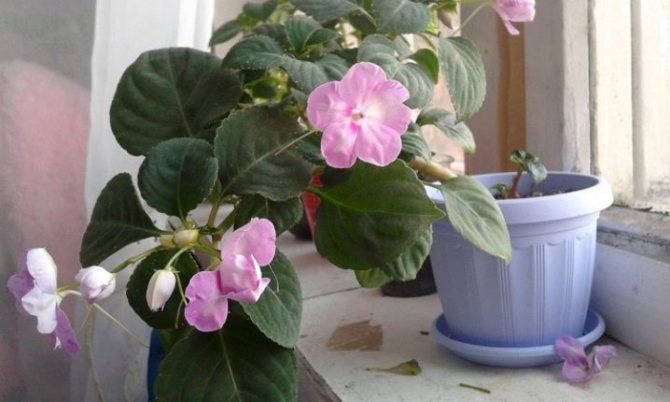

Diagnostics and treatment
Since there are several reasons for agnulitis, for quality treatment, in addition to examination and questioning by a doctor, a number of tests will be needed. In particular, this is a complete blood count, a blood test for sugar and a smear of the oral cavity for the presence of fungal and bacterial pathogens. In addition, you may have to visit an immunologist to correct the functioning of the immune system.
With a deficiency of vitamins and microelements, vitamin complexes, including increased doses of vitamins B2, B6, C and E, as well as iron and zinc, help to deal with seizures for a long time.
Fungal seizures can be treated with antibacterial ointments, in particular, levorinic, nystatin, erythromycin or mercury. If the causative agent is streptococcus, then only antibiotics will save (which ones will be prescribed by the doctor after determining the sensitivity of the bacteria).
It is not worthwhile to independently engage in drug treatment, because it is unlikely that it will be possible to independently determine the exact cause of angulitis, but it is easy to develop resistance to drugs in bacteria and complicate the task of doctors.
Before visiting the doctor, lubricate the "flame" with non-aggressive antiseptic agents, for example, chlorhexidine, potassium permanganate solution, tea tree or rosemary oil, aloe juice or honey. But "grandmother's" advice, like anoint with toothpaste or earwax, is not worth listening to - they will not relieve, but will only aggravate the problem.
The healing properties of Vanka Wet
In addition to his ability to influence people and the atmosphere at home, Vanka Wet is also valued for his healing properties.
Its numerous leaves are saturated with flavanoids. These substances, in addition to other positive properties, disinfect the air.Maybe for this reason, people, having long noticed that if there is Balsam in the house, family members get sick less, and attributed this to the superpowers of the plant.
The flower is also saturated with tannins, alkaloids, ascorbic acids.
Together with other herbs, a medicinal decoction was made from Balzamin for the treatment of festering wounds, it was used as an anti-inflammatory agent. To get rid of kidney stones and gallbladder, they also took a decoction with Balsam. It is able to grind and help remove stones from the body.
With rheumatism, it is advised to arrange bath procedures with a decoction from Vanka Mokroi. If, after waking up, you sit in such a healing bath, joint pain will not bother you all day.
Of course, before using Balsamin for medicinal purposes, you need to consult your doctor. Children and pregnant women should not use it at all.
In addition to his ability to influence people and the atmosphere at home, Vanka Wet is also valued for his healing properties.
Its numerous leaves are saturated with flavanoids. These substances, in addition to other positive properties, disinfect the air. Maybe for this reason, people, having long noticed that if there is Balsam in the house, family members get sick less, and attributed this to the superpowers of the plant.
The flower is also saturated with tannins, alkaloids, ascorbic acids.
Together with other herbs, a medicinal decoction was made from Balzamin for the treatment of festering wounds, it was used as an anti-inflammatory agent. To get rid of kidney stones and gallbladder, they also took a decoction with Balsam. It is able to grind and help remove stones from the body.
With rheumatism, it is advised to arrange bath procedures with a decoction from Vanka Mokroi. If, after waking up, you sit in such a healing bath, joint pain will not bother you all day.
Of course, before using Balsamin for medicinal purposes, you need to consult your doctor. Children and pregnant women should not use it at all.
Its numerous leaves are saturated with flavanoids. These substances, in addition to other positive properties, disinfect the air. Maybe for this reason, people have long noticed that if there is Balsam in the house, family members get sick less, and attributed this to the "superpowers" of the plant.
Impact on men
Balsam is more supportive of the stronger sex:
- It brings good luck, happiness, increases physical strength and endurance. Vanka wet contributes to the development of positive qualities.
- The flower pot is best placed in the office or at the head of the bed. it help you succeed in life. A man can easily achieve his goals, he will overcome any obstacles, realize all tasks. Balsam in the bedroom has a beneficial effect on potency.
- Sometimes the plant helps to find a life partner. But at the same time he has alcoholism may appear. Therefore, it is better not to get Vanka wet for those who have a tendency to addiction or in the past had a similar experience. Otherwise, a relapse is possible.
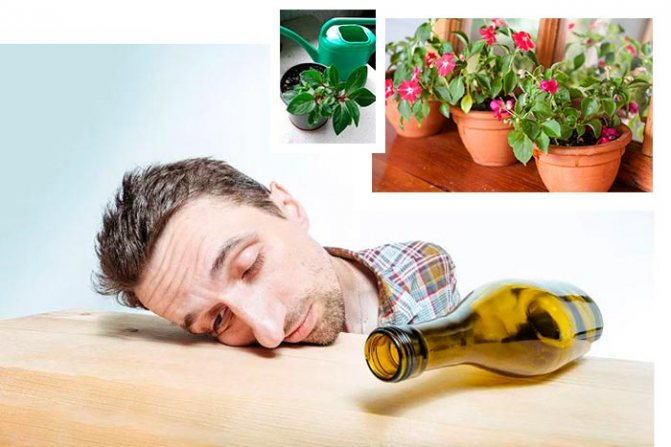

Causes of the disease
A skin disease localized in the corners of the lips (not to be confused with herpes, which does not have a clear location), belongs to the group of bacterial infections, namely streptococcal or fungal (Candida genus). Pathogens "jam" live in the body of every person, but in most cases - in an inactive state. They can be "awakened" by malfunctions in the body and subsequent violations of its protective functions:
- disturbances in the work of the gastrointestinal tract (constipation, frustration or flatulence);
- weakening of the immune system (as after ARVI);
- deficiency of trace elements, in particular zinc and iron;
- diseases of the oral cavity;
- lack of B vitamins;
- allergies;
- smoking (lowers the level of riboflavin in the body).
You will be interested in:8 secrets of strong immunity
In addition, the use of toothpastes with a high fluoride content and insufficient oral hygiene, trauma to the skin of the lips, as well as increased salivation or the habit of licking lips (leads to excessive softening of the skin around the lips, creating a favorable environment for the development of bacteria) can provoke the appearance of a jam.
In any case, if seizures bother you more often than once every six months, there is a serious reason to consult a doctor, because this can be a signal of more serious diseases.
Diseases and pests
In rainy and cool weather, balsam growing in a flower bed can get sick. The plant is often affected by fungal infections, due to which its roots rot, the stems darken, the leaves become covered with brown and gray spots, and subsequently wither. Preventive spraying with fungicides (Fundazol) saves from fungi.
Spider mite
The touchy is often attacked by insects, for example, aphids, whiteflies, thrips, ticks. Most often, balsam suffers from a spider mite. It is a small reddish insect that weaves webs and sucks sap from leaves.
Spraying with cold water, soapy water or insecticide treatment (Spark) is saved from the tick.
Viral mosaic
Impatient is affected not only by fungi, but also by viruses. The diseased leaves become covered with yellow spots, and then dry up and wither. Protecting balsam from the viral mosaic is not easy. The best preventive measure is proper care and adequate mineral supplementation.
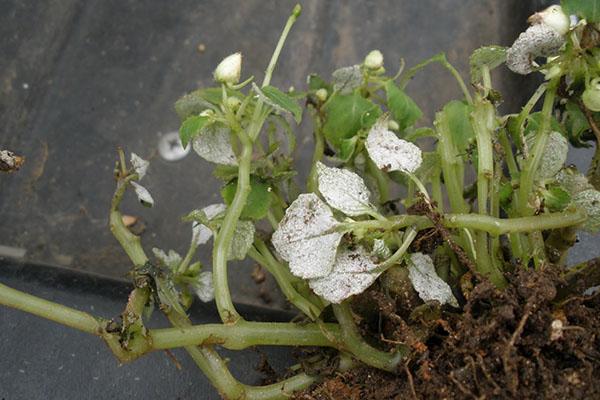

Bronze of leaves
With improper care of balsam, lack of potassium, after strong liming of acidic soils, the leaves can become covered with small dots of dead tissue, acquire a bronze color, become wrinkled, twist downward.
The bronzing of the leaves can be caused by a virus. As a preventive measure, the soil is disinfected with potassium permanganate before planting balsam, a sufficient amount of potassium and phosphorus is added.
Ring mosaic
Light round spots appear on the affected leaves of the plant. The disease is caused by a virus. Its vital activity can lead to the death of the plant. Correct care, timely application of top dressing, removal of weeds, spraying of soil and plants with a weak solution of potassium permanganate saves from the virus.
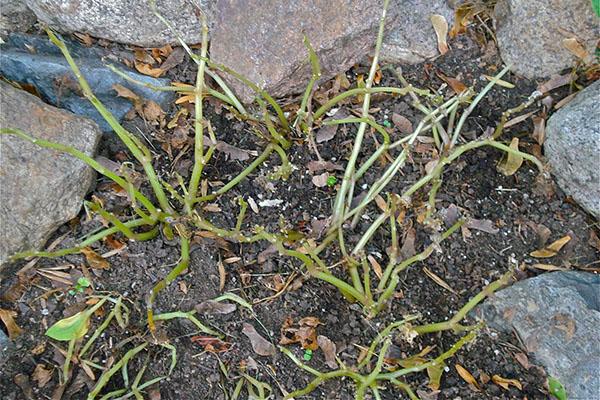

Photo
Here you can see a photo of a sick indoor flower:
Reproduction
Impatiens are propagated by seeds or cuttings. Seeds are sown for seedlings in March. At the end of May, the seedlings are transferred to the street. Cuttings from growing balsams can be rooted all summer.
Seeds
Roly Wet can be propagated by seeds. Usually, seeds are sown no earlier than March, when daylight hours become longer. Prepare the substrate before sowing. The soil mixture can be purchased or prepared independently from garden, leafy soil, with the addition of sand, peat. Seeds are sown on moist soil and covered with foil. Shoots appear after 1-2 weeks.
The optimum temperature for germination is 20-25 degrees Celsius.
Cuttings
Balsam can be propagated by cuttings, that is, cuttings in spring, summer and even autumn. The broken off upper branches must be put into water, and after a week they will sprout. Rooting can be done in wet sand or vermiculite. Then the cuttings with roots are transplanted into peat-garden soil.
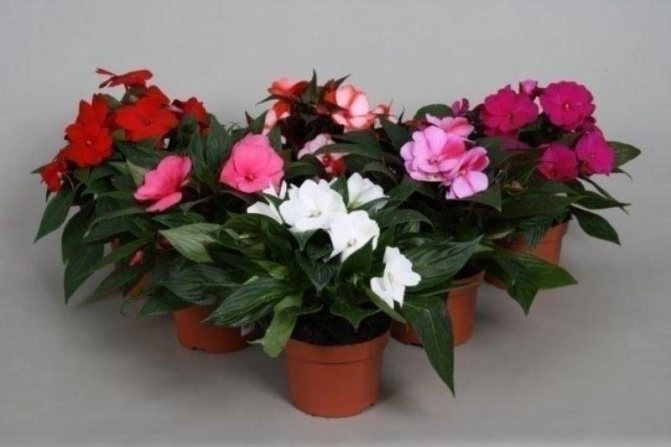

How to get the seeds right
Balsam blooms all summer, and in the fall, juicy fruits appear in the form of a box with seeds. Harvesting seeds is not easy. After all, the boxes explode from a light touch, and the seeds scatter to the sides. You can cover the boxes with a bag or bag and carefully collect the seeds in it.
It is practiced to collect fruits that are not yet fully ripe, which ripen in a dry room for several weeks. In the fall, after the fruits ripen, the annual plant is removed from the flower bed, and the next year new seeds are sown.The seed remains germinating for 3-5 years.
